
BLUE
WINTER/SPRING 2023 // FREE
MOUNTAINS

KHROMA KINETIC
Earn your turns with the new Khroma Kinetic. This lightweight ski mountaineering shell is for those who love the up as much as the down. Built with our softest hardshell Proflex™ fabric, it’s waterproof, windproof and packs down small. When you need one system to do it all, from remote touring adventures to stomping the steepest lines, this is it.

WWW.RAB.EQUIPMENT


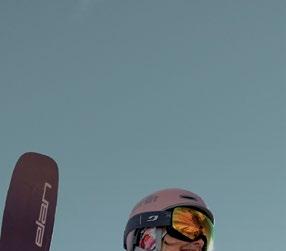



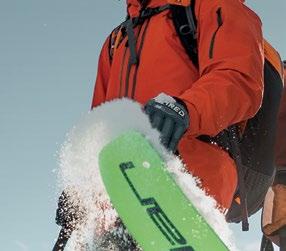



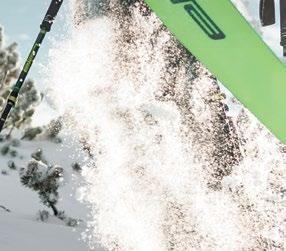


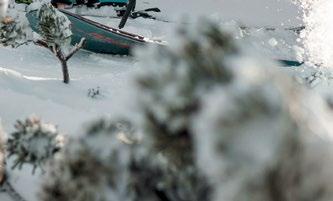


elanskis.com
Elan Family, Vogel, Slovenia, 2022










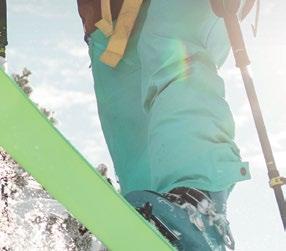


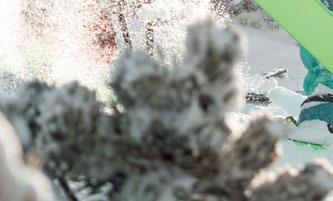




























































 THE GOLD STANDARD IN WARMTH
GERT BOYLE, FOUNDER
THE GOLD STANDARD IN WARMTH
GERT BOYLE, FOUNDER

Take me to t he top TREMBLANT.CA Royalty and taxes extra. Details at tremblant.ca 1-888-738-1777 SAVE UP TO WITH THE TICKET OUTLET BUZZING FROM PEAK TO VILLAGE 20 %
Elyse Saugstad BORN COLD

— Because we live the life you do, and ride the mountains you do, we design & craft the most protective apparel out there.
— We were born cold, we all need an extra skin.

— AK
Available at “4.0 Horizontal” Primary icon con g. Used on signage, business cards, website header. Hex code: EF001D
[o] Mason Mashon
Seek out fresh tracks in our latest freeride collection—built to go beyond the boundary.








 BEN POECHMAN / FREERIDE COLLECTION
BEN POECHMAN / FREERIDE COLLECTION

10
TABLE OF CONTENTS
FEATURE
P.18 Off-Piste ON DEPARTMENTS
P.15 SCOTTYTORIAL
The Great Freeze-Up
P.17 UPFRONT Classroom in a Park
P.29 TRAVEL Pow Highway Revisited
P.37 COMIN’ UP Snowboarder Jona Holden
P.41 INNOVATION Mushrooms are Medicine
P.44 EPIC TRIP True Eastern Alpine
P.48 RESORT TRIP La Belle Verticale
P.50 ARTIST PROFILE
Jeremy Down
P.55 MUSICIAN PROFILE

Beverly Glenn-Copeland
P.58 FOOD/DRINK
Still Fields Brewery
P.61 MOUNTAIN LIFER Riding Free
P.66 ATHLETE PROFILE Christina “Lusti” Lustenberger
P.77 MOUNTAIN HOME At Home in the Woods
P.79 WHEEL WELL Gravel Plans
P.82 BIOPHILIAC The Pollinator Bomb
P.84 GALLERY Winter and Spring Photographs
P.91 GEAR SHED The Finest Gear
P.98 BACKPAGE
Zen & the Art of Fly Fishing
ON THIS PAGE A team from Green Feet Dogsledding, Bruce Peninsula. ON THE COVER Self-portrait, Flowerpot Island. SCOTT PARENT
11
PUBLISHERS
Glen Harris glen@mountainlifemedia.ca
Jon Burak jon@mountainlifemedia.ca Todd Lawson todd@mountainlifemedia.ca
PRINT & WEB EDITOR
Ned Morgan ned@mountainlifemedia.ca
CREATIVE & PRODUCTION DIRECTOR, DESIGNER


Amélie Légaré amelie@mountainlifemedia.ca
CONTRIBUTING EDITORS


Allison Kennedy Davies allison@mountainlifemedia.ca
Colin Field colin@mountainlifemedia.ca
Kristin Schnelten kristin@mountainlifemedia.ca
Scott Parent scott@mountainlifemedia.ca
COPY EDITOR & PROOFREADER
Kristin Schnelten kristin@mountainlifemedia.ca
DIRECTOR OF MARKETING, DIGITAL & SOCIAL
Sarah Bulford sarah@mountainlifemedia.ca
FINANCIAL CONTROLLER
Krista Currie krista@mountainlifemedia.ca
DISTRIBUTION
Brendan Thompson brendan@mountainlifemedia.ca
CONTRIBUTORS
Leslie Anthony, Ryan Carter, Melanie Chambers, Sarah Chisholm, Geoff Coombs, Alain Denis, Jeff Fletcher, Molly Hurford, Maddie Johnson, Dustin Johnston-Jewel, Jenna Kitchings, Benny Marr, Drew McIvor, Conor Mihell, Carl Mitchener, Ryan Osman, Jason Petznick, Richard Roth, Dan Rubinstein, Annie Rusinowski, William Tam, Heather Thompson, Tom Thwaits, Leslie Timms, Kyle Wicks, Jody Wilson.
SALES & MARKETING
Glen Harris glen@mountainlifemedia.ca 705 441 6334
Bob Koven bobby@mountainlifemedia.ca 416 721 9940
Stephanie Martinek steph@mountainlifemedia.ca 705 441 3684
Mike Strimas mike@mountainlifemedia.ca 416 779 7908
Lindsay Earle lindsay@mountainlifemedia.ca 416 553 5658
Jeremy Gourlay jer@mountainlifemedia.ca 705 606 5843
Forest Stewardship Council
Life
All rights reserved. Reproduction
is
Life
your
OUR COMMITMENT TO THE ENVIRONMENT Mountain Life is printed on paper that is Forest Stewardship Council ® (FSC ®) certified. FSC ® is an international, membership-based, non-profit organization that supports environmentally appropriate, socially beneficial and economically viable management of the world’s forests. Mountain Life is also PrintReleaf certified. It measures our paper consumption and calculates the forest impact. Our paper footprint is automatically reforested at planting sites in Canada.
Published by Mountain
Publishing Inc, Copyright © 2023.
without permission
prohibited. To distribute Mountain
in
store please call 705 441 6334.
Be GEORGIAN COMMUNITIES

a Another project developed by:


Windfall

part of an inspired enclave where nature & neighbourhood are in perfect balance.
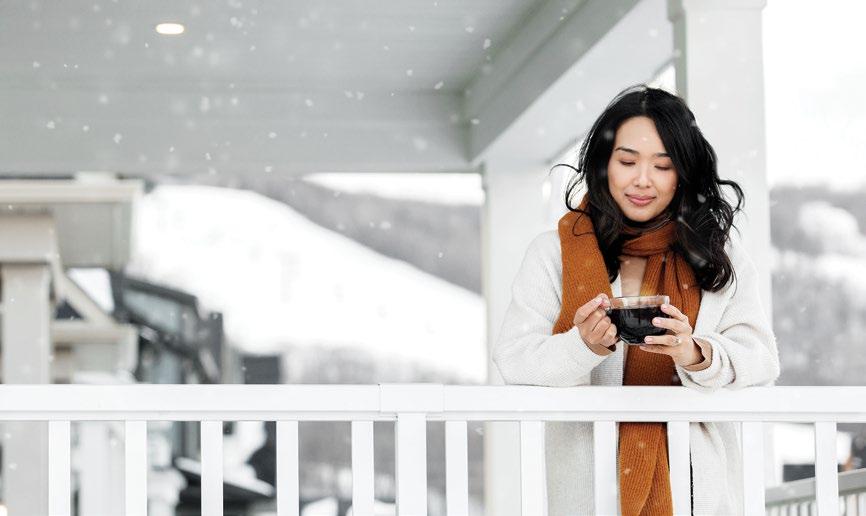

WindfallatBlue.com
This is Your
Welcome to the next phase of mountain homes nestled between Blue Mountain Resort and the award winning Scandinave Spa. A community set proudly apart yet connected by nature. Distinctive architecture inspired by Georgian Bay cabins and mountain chalets. This is everything you want Blue Mountain living to be. This is your Windfall. Phase 6 Now Selling. Contact us today. SEMIS BUNGALOWS TWO STOREYS
HELI-ASSIST SKI TOURING
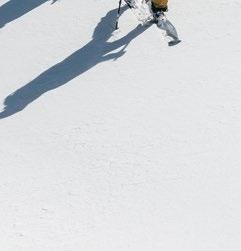






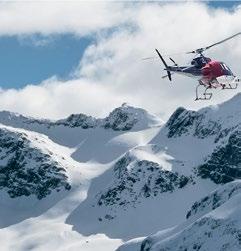
Whistler,





STEP
STEP
STEP
STEP
STEP
STEP


British
Columbia
1 A scenic helicopter ight to the top of a remote peak
2 Descend 1,000 ft of bottomless powder turns
3 Throw on your touring skins, drop a layer, hike back up
4 Repeat all day
5 Helicopter pickup at the bottom of your last run
6 Fly home for Après!
THE GREAT FREEZE-UP AND WHY IT MATTERS
It’s January. My morning scroll of the Lake Huron MODIS satellite imagery happens over coffee. Produced daily by NOAA CoastWatch (Great Lakes Region), the MODIS satellite is one of the tools used to measure surface ice concentration on the Great Lakes.
Nine out of 10 of these images usually turn out completely cloud-covered and provide zero insights into current lake ice conditions. But every so often a clean image reveals itself following a clear day and details a visual update of the lake surface as it freezes over the course of winter.
In 2015, a rare freeze-up occurred: Lake Huron peaked at over 95 per cent ice concentration, the volume of surface ice necessary for a winter crossing of the Bay. Zane Davies and I made the 88-km SUP trek that winter, departing from Neyaashiinigmiing and arriving at Twelve Mile Bay after three days of navigating through the labyrinthine aqua firma. After that, the door was shut and the winter of opportunity hasn’t formed since.

Historical ice-cover graphs appear like a heart rate monitor that oscillates and contracts along a linear chart. The second-highest peak for ice concentration ever recorded happened in 2014 at 92.4 per cent coverage across Lake Huron (followed a few years later by a low 19.4 percent ice coverage in 2017). It bounced back up to 80.9 percent in 2019 whereas 2020 generated another low at 19.5 percent.
The frequency of years hitting extreme low is increasing year to year, while the span between them is notably shrinking. These extremes affect more than 6,100 km of shoreline across Lake Huron, and force drastic environmental changes upon coastal animals, birds and fish.
For native fish species of the bay such as lake whitefish (Coregonus clupeaformis; atikamekw in Anishinaabemowin), surface ice is a shield of defence from the brutality of winter storms. Whitefish spawn along shallow rock reefs in the fall, and their eggs must endure the long winters in order to hatch in spring. Less ice means less protection for their life cycle.
The shallow waters between outer reefs and the shore become protected nurseries for native fish species, and shoreline ice acts as a buffer or breakwall that protects the surface from being stirred into significant wave action. Ice cover also filters out the sunlight from penetrating deep into the water.
Light penetration and prolonged wind events can also disrupt the spawning cycle of cisco (Coregonus artedi; odoonibiins in Anishinaabemowin)—a vital native preyfish species who prefer to spawn in the dark motionless waters beneath snow-covered ice.
Similar to whitefish and other native fish, cisco populations have been heavily depleted by fisheries over decades.
Ice cover on the bay has helped protect and nurture these native species that were once plentiful and evolved with the formation of ice and the seasonal cycles of the Great Lakes region.
I hope for more winters like 2015, when we made our successful SUP crossing of the bay. For the sake of those fish beneath the ice and their young. And for the families they feed. And for future generations, that they can experience the wintry wonders of the bay as I’ve been lucky enough to know them. What would it mean if the old winters never return? That’s something I cannot fathom. –Scott Parent
15 SCOTTYTORIAL
Navigating over ice and open water during the 2015 SUP crossing of Georgian Bay. SCOTT PARENT
It’s what’s inside that matters.








The Swany X-Plorer Glove with TriPlex Alpha is 30-50% warmer than standard insulations, fully waterproof, highly breathable and ultra comfortable.










swanycanada.com
Photo by Guy Fattal
Classroom in a Park
Blue Mountain Wild School takes learning outside
It’s 9 a.m. on a mid-December morning, and Blue Mountain Wild School parents are lazily rolling in for dropoff. Traipsing through the trees to morning circle, kids bouncing off one another and teachers following behind, the scene feels less school day and more summer camp—with lots of layers.

At morning circle the entire student body (about 45 children, kindergarten through Grade 6) gathers to ready themselves for the day ahead: warm-up exercises, “O Canada,” class updates, announcements and a gleeful lap from the birthday boy and his class.
Afterward, students break into grades and head to classrooms. Not ready yet to settle into desks, they pause only to gear up for the morning hike: notebooks, pencils, maybe some extra mitts.
Every morning at Wild School starts in the same fashion, no matter the weather: Play for a bit. Gather together. Take a hike. Then back in the classroom to focus on long-term projects. Maybe it’s a unit study on lesser-known Canadians or a comparison of life in the Arctic versus Antarctic.

“At the beginning of every month the teachers sit down with the students and brainstorm, asking, ‘What do you want to learn about?’” says Director of Education Brayden Plummer. “When students are engaged in the topic, they are excited about learning. You still hit the same Ontario curriculum expectations, but they’re taking the lead. We’re going to teach writing, whether we’re writing about penguins or Vikings. Giving them that ownership of the topic is huge.”
“It’s a living curriculum, a new model we call natural education,” says Founder and Executive Director Jeff Barrett. “It’s the path of least
resistance; it’s how our brains want to learn. And it’s easier for the teachers to teach children who are engaged. It’s harder in some ways, because they’re having to constantly build curriculum, but we give them extra prep time, and they love the process.”
But academics is only one piece of the puzzle. “You’ve got to focus more on the physicality, the emotional side of it,” adds Barrett. “Moving from indoors to outdoors throughout the day is critical, trying to really connect with nature. Research shows the effects of nature are profound: cognition, brain development, reduction of stress, improvement of happiness.”
Located south of Heathcote on 100 acres of mixed forest and fields connected to conservation lands, the school’s separate pods—a mixture of new buildings and geodesic domes—create what Barrett calls “classrooms in a park,” including outdoor learning spaces with rain and sun protection in warmer weather and kilometres of hiking and ski trails.
“What we’re demonstrating here is a new model of education. And we’re hoping this is going to start to take root, to influence other programs and teachers,” says Barrett.
“It’s just this win-win-win model. Kids are out of their desks, off their screens; they’re healthy, active, engaged. And the result is happy students who are loving learning, and having a ball doing it.” –Kristin Schnelten
Learn more about Blue Mountain Wild School’s educational philosophy and programming at www.wildschool.ca

17
UPFRONT
KRISTIN SCHNELTEN
Off-Piste On
We’re leaving the ski area.
Can you blame us? The ungroomed, untouched and unadulterated terrain that lies beyond the resort boundaries is the stuff of skiers’ dreams.
As wintery air moves across the Great Lakes, the wind picks up moisture from the water and releases it over the escarpment as lake-effect snow. It’s a siren call for skiers and snowboarders to strap on their gear and score tracks. And while a healthy number of ski resorts and nordic centres operate in the area, more and more people are opting to venture off the groomers.

B.C. and Alberta may offer the biggest, deepest and most consistent backcountry/sidecountry in Canada, but if you ask Greg Sturch, it’s no duopoly when it comes to earning turns after a thick snowfall.
“It’s fun, you feel good and it’s adventurous… All here in our own backyard,” said Sturch. “It’s everything that skiing from a chairlift isn’t.”
Sturch has been skiing Ontario’s backcountry for more than two decades, and he’s learned a thing or two about lake-effect snow and the opportunities it presents. A

Collingwood native and avid skier, hiker and mountain biker, Sturch is on the escarpment all year round, always keeping an eye out for clean lines and an open pitch to explore as soon as the snow sticks.
He said when it comes to the Ontario backcountry, “It’s very opportunistic.” You can watch the forecast, but it’s only somewhat reliable. Instead, you have to be strategic; when the snow falls, you drop everything, call your buddies and make your way out as soon as you can.
One call will often be to long-time friend Brennan Basnicki. Basnicki grew up a ski racer then became a race coach, splitting his time between Collingwood and Toronto, but he said he was never the best among his racing friends, and would opt for powder trips over training camps any day.
For him and other lake-effect warriors like Laura Tombolini, making the jump to the backcountry was in part a product of being tired of long lift lines. Both Tombolini and Basnicki said they have basically given up on resort skiing in Ontario, especially on weekends.
Fortunately, unlike the resort rush after a snowfall, where there’s about 20 minutes before it’s tainted, the beauty of touring the escarpment is its vastness. If you put in the work, which means really studying the public trail
ONTARIO BACKCOUNTRY FEATURE
words :: Maddie Johnson
18
FINDING SHRED-WORTHY TERRAIN IN SOUTHERN ONTARIO IS A HARD-FOUGHT WAY OF LIFE
networks in the region, there are so many options for touring. When there’s a big dump of snow, you can shred fresh powder all day, if you’re willing.
“It doesn’t even feel like you are in Ontario,” said Tombolini. “To have complete silence, and feel the sun cracking through… It’s this perfect mix of adrenaline, but also bliss.”
Tombolini had her first real backcountry experience last winter, thanks to Sturch and Basnicki, and she didn’t bother purchasing a pass this year because of it.

Not only does the backcountry allow you to trade in busy lift lines and swarms of beginner skiers for the deafening silence only experienced after a big snowfall in the middle of the woods; the benefits go well beyond that.
One of the biggest draws of touring is the workout. When you’re on a steep pitch, almost at the end of your ascent, the burning in your legs and lungs feels weirdly fantastic. Sweat is inevitable, even on the coldest days, but it makes the experience all the more worthwhile because you’ve earned each of those turns. And the beauty of exploring the backcountry in Ontario is you don’t actually have to go all that far off the beaten track to get to it.
“Even if you only get five turns in waist-deep powder, it’s still five turns in waist-deep powder,” said Sturch. Plus, according to Basnicki, the après on the backcountry generally happens in the backcountry. “Beers with your buds in the bush, you can’t top that,” he said.
Backcountry skiing also doesn’t confine you to one route like riding a chair lift does. Once you get more comfortable and confident, you can explore different routes and begin to challenge yourself with tougher terrain.
That said, the danger factor can’t be ignored, and it’s true that the barrier to entry is significantly more difficult given the equipment needed. “There is always a level of awareness, how steep is the pitch, what else is around,” said Struch. “The conditions are variable, there are trees everywhere, you would never want to attempt it if you don’t know how to ski powder.”
But for off-piste aficionados, it makes it all the more worthwhile. “It’s crazy, but it’s a very calculated crazy. That’s the best part,” said Tombolini. “As much as it is madness, there is some strategy to it.”
And at the end of the day, there is truly no thrill like floating through fresh powder, going full-send as you weave through twigs and trees. It takes more thought, more patience and more practice. And yes, you will fall.
“Earning your turns, doing something that most people don’t—there is that sense of accomplishment,” said Basnicki. “My worst days in the Ontario backcountry are still a hell of a lot more fun than going to the gym.” Feature continues on p.21

19
LEFT PAGE & ABOVE Erika Langman. RYAN OSMAN. RIGHT Jesse Bond. JODY WILSON



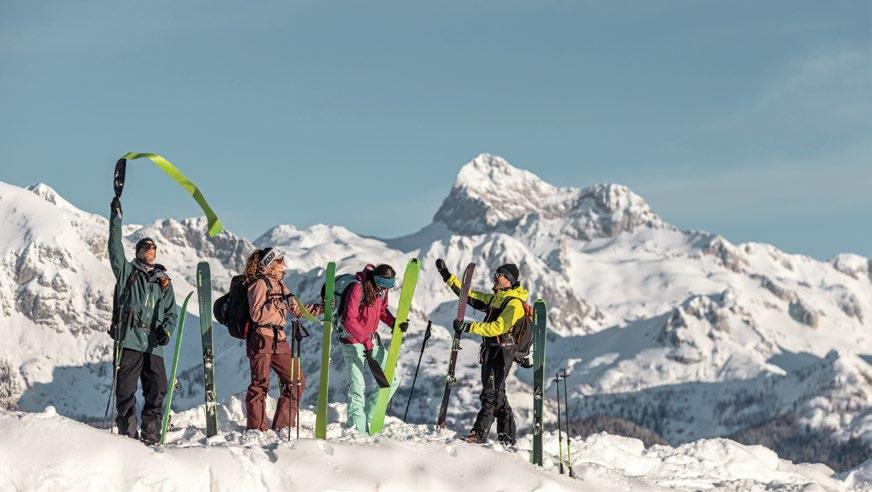
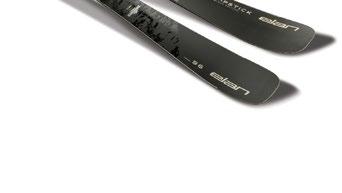




















Alpine & Nordic Touring Sales | Service 15 Balsam St. Collingwood 705-444-5488 In Stock Touring Equipment and Apparel www.LittleEds.com Equipment
Gear Up to Skin Up
We talked to Devin Montgomery of Skiis & Biikes about the recent increase in touring/backcountry gear demand and how you should outfit yourself to shred happy in the woods this winter.

Mountain Life: How much has touring gear increased in popularity over the last few years?
Devin Montgomery: We're seeing a big uptick in people buying touring boots with a pin-compatible toe. They have a walk mode, so you can get to the hill from the parking lot a little bit easier. And we're seeing more touring-binding sales. The Armada Shift binding or the [Marker] Kingpin binding are a little more robust, especially in the heel. So you have a little bit more crossover between on-hill and going uphill. For skis you can mix and match—you can get a Volkl Blaze, which is a nice light ski, but then skis really well on-piste and in powder. It's not specifically a touring ski, but we see a lot of these multiuse light skis getting set up with touring bindings.
ML: And you can put skins on if you want.
DM: Absolutely. But we don't sell too many skins, which is interesting. We sell a lot of [touring] boots, bindings and binding-and-ski combos, like Volkl or Black Crows. And Armada's got a new ski out called the Locator. Now I think our Ontario clientele are seeing that their clubs have touring loops.
In our pro shop we rent all this gear now to folks who just want to try it out. They're very curious because you can get kind of bored to tears if you're just skiing Ontario hills all day. So [touring] is a great afternoon workout before hitting the bar.
ML: Do you carry fat Nordic skis that you can carve with?
DM: The Fischer Traverse 78 is the widest we sell. It's definitely a very wide cross-country ski. But you can't lock your heel in these. So downhill skiing is going to be sketchy. For downhill, you can go down a steep hiking trail or a farmer's field that has a big hill on it—holding on for dear life and straight-lining it.
ML: But these wider skis can handle slope much better than your average all-purpose Nordic ski.
DM: Yes, just in the edges alone you have more stability. I think the cores are a little bit stiffer. There’s a wood core in some models so that also adds some torsional rigidity—better for stability downhill versus a foam core that’s mainly just focused on lighter weight. And the big benefit of having a wider ski is for breaking a trail. So you can go anywhere with the dog, maybe towing a little sled. The Bruce Trail would be perfect. I think this is where these skis really fit in, not necessarily as an alternative to a touring ski.
21

22
Mark O’Grady, Algoma COLIN FIELD
Splitting in Ontario?
WITH TECHNOLOGICAL ADVANCES IN THESE HIGHLY SPECIALIZED BOARDS, IT’S MORE APPEALING THAN EVER
words :: Carl Michener
Alister Horn grew up snowboarding in southern Ontario, progressing from the mighty Glen Eden to Mount St. Louis and Blue Mountain Resort in the early 1990s. He now lives in Salt Lake City and hasn’t ridden a groomer in more than eight years. But that doesn’t mean he’s given up boarding.
Horn discovered the joys of splitboarding back when hardly anyone had ever heard of it. “Splitting,” as it’s known, follows the same principles as backcountry skiing: skin up and ride down. Savour the pump and the scenery as you climb, then snap your board together and indulge in true backcountry riding where every turn is earned.
First, imagine building a board perfect for backcountry terrain. Then, figure out how to make the two halves perform as well as skis on the way up. The two aims are not that easy to reconcile.
While ski touring has been around for decades, splitboarding didn’t get its start until the early 1990s when Voilé (also based in SLC) launched what was arguably the first production splitboard, the Split Decision. The sport wasn’t an immediate hit. “When I started in the early 2000s, splitboards weren’t all that great,” remembers Horn. “No snowboarders were taking it seriously back then.”
THE MAKING OF A SUCCESSFUL SPLIT
The technology has advanced by leaps and bounds since then. Splitboards aren’t just resort boards cut in half, although cutting boards in half is how Horn started out. The former engineer eventually founded Chimera Backcountry Snowboards, the only company 100 per cent dedicated to the fine art of splitboard production.
First, imagine building a board perfect for backcountry terrain, either big mountain or powder riding. Then, figure out how to make the two halves perform as well as skis on the way up. The two aims are not that easy to reconcile. Most manufacturers try to solve this by wrapping a full edge around each ski, resulting in twice the metal of a traditional snowboard. The steel makes splitboard halves stiff, yet the board is often wobbly on descents. On their high-end hand-
built boards, Chimera makes the sidewall and edge out of one piece of super-tough plastic. That gives splits the stiffness they need for climbing and the required dampness for descents. Grip is not sacrificed, however, because the two halves of a splitboard are swapped when skiing. That way, the downhill inside edge that’s doing most of the work is always a metal edge.
SPLITTING IN ONTARIO
Chimera was a small, niche company until Covid hit. “Then splitboarding just blew up,” remembers Horn. “The market almost doubled between 2019 and 2021. I quit my day job.”
Most of Chimera’s customers are big-mountain riders and mountaineers, but the company does have a faithful following in the northeast. The trend is growing at the same pace here as elsewhere, from Sault Ste. Marie and Sudbury to the Niagara Escarpment and Haliburton Highlands.
Macalin Green, who works at Fathom Boards in Collingwood, rides splitboards with a local crew. They hit lines on both sides of Scenic Caves * Road, on land adjacent to Osler Bluff Ski Club and (for the most part) in Pretty River Provincial Park.
Since the pandemic began, Green has noticed that the number of splitboarders coming through the doors at Fathom has roughly doubled. That may be because a lot of resorts now allow uphill travel—a big deal where backcountry access is hard to find. Blue Mountain Resort, for example, has allowed skinning up The Grind since 2017. “We have seen strong community adoption [of skinning] and plan on continuing to support it,” comments Matt Baird, Director of Slope Operations at BMR.
The popularity of splitboarding exploded during the pandemic when resorts were closed, but those who gravitated to it haven’t hung up their splits. Boarders recognized that skinning up and riding down is a great endorphin rush and good fun. But accessing the backcountry is splitboarding’s true raison d’être.
“The backcountry you’re riding is epic, video-game terrain in deep pow, as opposed to some blown-out groomer with a thousand other people,” comments Horn. “Also, the touring is wicked fun. Spending the day in the woods, bullshitting with your friends, stopping for lunch. The riding is just the cherry on top.”
What do you need to get started with splitboarding? A pair of snowboard boots, some collapsible poles, a splitboard and skins. And avalanche safety training if you’re in big mountains. For outfitting, try www.SplitboardHQ.com or buy direct from your favourite brand.
* Location redacted to protect pow-stash integrity.
23
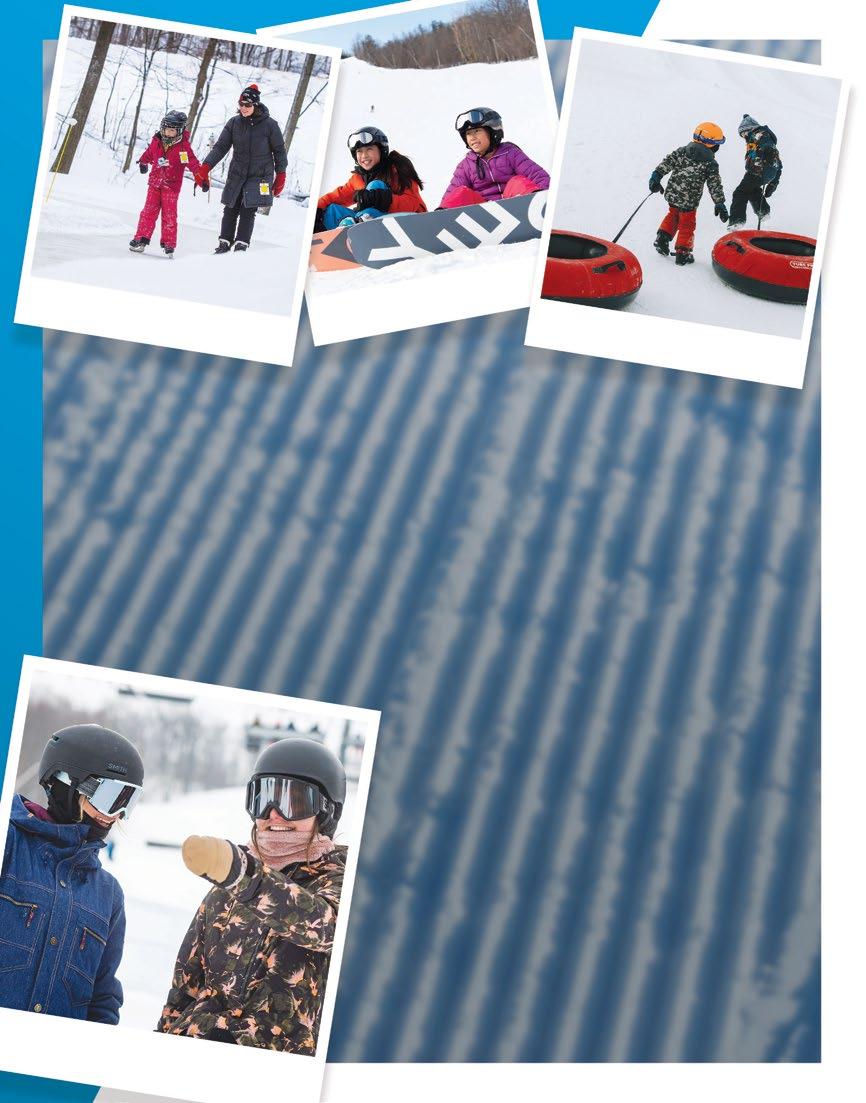
Take learning beyond the classroom and give your students an unforgettable, inclusive learning experience Blue Mountain Resort is a worldclass outdoor education facility, unsurpassed by any other in Ontario. We bring the Ontario Curriculum to life through our year-round experiential education offerings for students of all abilities in Kindergarten through grade 12. • Customized day and overnight trips • Aligned with the Ontario Curriculum • Inclusive, Safe, Affordable Breathe Fresh Air Into Your Curriculum www.BlueMountain.ca/SchoolTrips or Call 1-833-583-BLUE
Touring for Tenderfoots
ONTARIO OFFERS AN IDEAL ENVIRONMENT FOR BEGINNER SKI TOURING
 words :: Heather Thompson
words :: Heather Thompson
Ski touring has a long and storied tradition in Europe, but in North America, until recently, it was primarily the realm of mountaineers or extreme skiers. While its popularity started to rise a decade ago with improved gear and publicity from big-name skiers, demand skyrocketed due to Covid and the closure of ski resorts. And its original purpose has morphed into an economical, sustainable and calorie-burning alternative to resort skiing.
Touring gear is almost indistinguishable from a standard downhill setup at first glance. There is even a new crossover genre of gear that can be used for both backcountry and resort skiing (see p. 21 “Gear Up to Skin Up”). As a keen ski tourer who recently relocated to southern Ontario from out west, I was keen to see if there was any local touring, especially as I was training for a ski-mountaineering traverse in the Rockies. I was disappointed to discover very few touring options. (In Quebec, resorts like Tremblant have dedicated skin tracks, and a lower-priced touring ticket.) Blue Mountain Resort boasts a fairly new skin track, and while some private clubs also offer them, you must be a member to access their trails. The only other public Ontario hill offering ski touring, Calabogie Peaks (near Ottawa), does sell a very reasonable touring ticket for $5.65. For those willing to travel a bit further afield, I found two more intriguing options.
The West Wind Highlands Ski Touring Association (WWHSTA) is

a not-for-profit founded in 2020 by a group passionate about selfpropelled turns in the Muskoka, Almaguin Highlands and Haliburton regions. Stretching along the west side of Algonquin Park, their playground has more public land and rolling topography available for would-be ski-tourers than the rest of southern Ontario, and a more reliable snowpack. While the gently undulating terrain of Ontario’s forests may not compare to the spectacular array of options in Alberta or B.C., it offers locals and beginners a lot of safe and forgiving options. The WWHSTA offers events such as Twigfest, one of Ontario’s only backcountry ski/snowboard festivals.
For those willing to venture a little farther, Bellevue Valley Lodge, just north of Sault Ste. Marie, offers access to 1,000 acres of gladed trails and up to 200 m of vertical (not to mention an average of 250-300 inches of snow per season) for a nominal day-access fee. For those coming from out of town, they offer accommodations as well as trails for those who prefer snowshoes to skis.
Maybe Ontario hasn’t been blessed with the Rockies’ towering peaks, but thanks to the Great Lakes, we are fortunate to have plentiful snow and some decent hills to get in a skinning workout and a few hard-won turns. (Overlooked bonus: The avalanche threat here is non-existent!) With increasing inflation, mounting concern about the climate crisis and the carbon footprint of ski resorts (and air travel) and an uptick in appreciation for fitness thanks to Covid, perhaps the time has come for uphill skiing in Ontario.
25
COLIN FIELD
crafted to ski more.

the new ranger series












































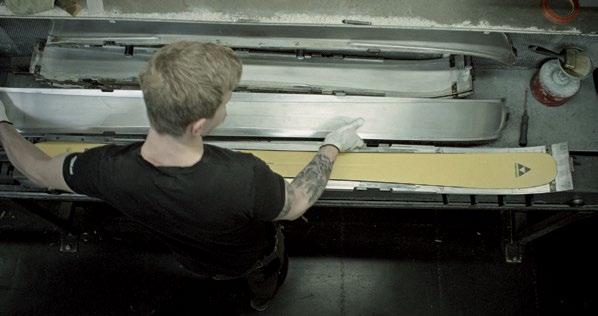
Ski more! That is what we all want and the intention behind the new Ranger Series. The Ranger ski line is the result of 30 months of intense collaboration between team athletes, shop employees, ski engineers, and ski addicts with the aim of getting more out of every day spent on snow, regardless of conditions or the terrain. The Ranger line is made in Europe with as much recycled material as possible.








Skiing is not a lifestyle. It’s life.



NEW RANGER SERIES AVAILABLE IN ONTARIO AT: Skiis & Biikes - The Sign Toronto - Rick’s Pro Ski Shop Blue Mountain Resort - Kunstadt Sports
Free Your Heel, and Your Soul will Follow
words :: Jeff (Fletchy) Fletcher

Hooks and D-rings. Hard-shell boots with baffles, allowing toes and metatarsals to fold toward each other. Flaps extending from the toes like the bill of a baby platypus. Stainless steel mounting plates snaring the toe flap. A heel clamp, dangling free. And the essence of it all: the double-barrel coiled telemark cable binding.
This gear, passed on from a friend years ago, languished in the shed, getting jumbled around seasonally as we searched for other items. But when the world locked down, those telemark skis became a human-powered chairlift.

It was a good-quality binding and boot setup, but the skis were atrocious. Mounting the steampunk-esque bindings on a beauty set of low-mass all-wood-core powder skis started me on a new skiing journey. Armed with a pair of compostable bamboo cross-country poles and a pair of extra-thick Icelandic sheep-wool socks—to make the slightly large boots fit—this rookie was ready.
Skiing in Ontario for 40 years or so can get boring. Telemark is a time machine, taking you back to the days when a black-diamond run gave you pause. There aren’t many taking a knee these days, but tele-skiing has a real place in this world. Add skins to your skis, and you’ll see the escarpment with fresh eyes. The oft-repeated mantra of tele-skiers is true: When you free your heel, you’ll free your soul.
Tele stuff is relatively lightweight, so sidecountry trekking is easy and has the added reward of a few turns in some untouched drops. Places like Awenda Provincial Park and the clay bluffs between Meaford and Thornbury also allow for the added bonus of a wintertime skirt along the Georgian Bay shoreline. Earning your turns with your skins and teles also creates line-up–free days on the weekend at resorts that allow skinning on trails. As the hoards jam the chair lifts, these spaces off the slopes are peaceful. You won’t burn a record number of laps or mark the fastest speed on a snow app, but you also won’t need to—you’ll be free in a completely new zone.
The decline of tele is real, but for me it was a natural evolution on my ski learning curve. My alpine abilities have plateaued, and my days of park runs are likely behind me. Tele slapped me back down to the bottom of the curve. It is an inventive challenge; tele skiing is part sport, part art form and on the rare powder days it’s a dance of flowy turns.
27
Andrew Lansdale. KRISTIN SCHNELTEN




PACKAGES & DEALS
Powder Highway Revisited
Back on the road with three generations, dancing lifties, best-on-planet pizza and elusive-but-exquisite pow days
A lifetime ago, I met a pretty swell guy on a big-mountain road trip. After a full month in a Subaru, criss-crossing the Rockies to ski five states and two provinces, we emerged— beaten, battered, exhausted and coughing—with a few certitudes: We’re getting married. And: That was fun, but holy hell. Twenty stops was a few too many.
Seventeen winters, a worldwide pandemic and a healthy dose of cabin fever can wreak havoc on one’s memory. By the time Thornbury Lockdown 18.0 arrived, we were gazing longingly at the B.C. map. Let’s take the Powder Highway again. Retrace some of our steps—with the children and grandfather, of course. Why not, really?
Crammed this time into an embarrassingly massive rental SUV, our circle loop would take the five of us from the Calgary airport to Fernie, Rossland, Nelson, Kimberley, Invermere and out through Canmore. Seven condos, hotels and cabins in two weeks. But who’s counting?
In Fernie, full of anticipation—real mountains! Real snow! Skimovie-worthy powder turns are imminent!—we clomp through the base area to meet Christine. From whom we re-learn an invaluable lesson: The key to a glorious day is an outstanding local guide.
The weather is pretty much shite. Visibility is low. Our useless goggles are caked in ice, and removing them is an open invitation for ice pellets. But we don’t care. We whoop through the pain, we find the fresh snow. The boys launch all the kickers, my daughter survives
her first ungroomed gully and genuinely (finally, after nine years on skis) falls in love with the sport, exclaiming mid-turn, “The snow! It’s so soft! And there’s no one here!”

That night we feast on mounds of curry from Himalayan Spice Bistro and decide we’re never, ever leaving. We’ll move to Fernie and Christine will be our best friend.
The next morning dawns clear, revealing the peaks and couloirs hidden behind yesterday’s clouds. After another full day on the mountain, our attempt at a post-ski fat-biking session is laughable. Who has legs left for this struggle? We throw in the towel and hit the bar for nachos. Then the brewery. Later, we order the best pizza on the planet. (Sweet Beaver from Funky Goat Pizza for the win, folks.)
At every path, sidewalk, shop and lift, we encounter kindness. Friendly, warm and welcoming locals. A genuine, non-corporate, oldschool vibe. Picking up our pizzas, the cashier confides, “I came here for one season and never left. Everyone is so nice here; it motivates you to be a nicer person.”
A quick MLS search makes us feel a bit less welcome, but our spirits are not yet broken.
Stuffing gear into bags, we begin a routine of small discoveries that repeats over the next two weeks: Man, real mountain towns are chill. Wow, is it ever beautiful. Crikey, Tetris-ing ten bags into the truck every other morning is a total pain in the arse. And damn, wouldn’t it be nice if it would snow?
29
words & photos :: Kristin Schnelten
TRAVEL
After that first socked-in day at Fernie, we spend the rest of our trip skunked. Some places haven’t seen a dusting in weeks. The trip becomes an adventure in fast groomers, delicious food and fine people making the best of what they have.


At Red Mountain we wave to groomers from our balcony hot tub. We ski rock-hard moguls beneath vintage Erector-set double chairs. And we feast on edible art at the ultra-swanky Velvet restaurant.
An overnight at the on-mountain Constella Cabins takes us out of our comfort zones and into the stars. Après at Rafters, we bump into buddies we made along the way—guides, hosts, lifties—then we’re off to Idgie’s for a classic retro dinner, straight from the 90s: Frenchonion soup, pasta with sun-dried tomatoes and oozing lava cake.
By the time we make it to Whitewater, Pappy’s sciatica is irate. Skiing is great—sitting, too. But standing and walking? Forget it. We lap the Summit chair and he takes off ahead each time, waiting for us at the top on his makeshift snowbank bench.
At the base, our liftie dances in ski boots to Bluetooth reggae swinging from his chest rig. “Tubular!” he calls out after beeping my son’s pass. “Universal!” for my daughter. My husband and I get “Far out!” and “Wicked!” but the next skier totally wins with “Galactic!” This guy is hilarious, and we’re in heaven.
Whitewater has soul. Whitewater has personality. And Whitewater, it turns out, still has some snow. We find it hidden under the Glory Ridge chair, then break for lunch with the incomparable Mikey Bourke, head dude at the Glory Lodge. There’s zero room for chit-chat between lip-smacking Mmmmms and Ohmygods.
We pack out of our funky boutique Cloudside Hotel in Nelson and book it over the Kootenay Pass to Kimberley, where our single night/single-ski-day plan is nearly the death of us.
Dragging luggage into the posh and trendy Larix Hotel, we frantically clean up for our reservations across town at the Old Bauernhaus. The schnitzel is worth the stress, but the next morning’s 7 a.m. checkout is brutal.
Our useless goggles are caked in ice, and removing them is an open invitation for ice pellets. But we don’t care. We whoop through the pain, we find the fresh snow.

30
Sunrise from a snowcat, though, is pretty sweet.
When an arsonist destroyed the control centre of Kimberley’s main lift early in the season, local resorts immediately stepped up to help, including the loaner Revelstoke cat that rumbles us and our guides to the top.



It’s a Saturday, and we feel like we’re one of 100 people on the hill. Sure, it hasn’t snowed in days. But the views are forever and the grooming is top-notch. Meegan encourages my daughter while Rob heads into the trees to seek out soft spots with the 14-year-old on his tail. Tree-run-obsessed Pappy opts out—for the first time in four decades—announcing dramatically, “The torch has been passed.”
We have only a brief moment to savour the grandfatherly sentiment before we’re shoving off from Kimberley, on our way to possibly the greatest meal of the trip at Birchwood Restaurant in Invermere. We catch up with an old friend, then we crash. Hard.

Panorama, at the tail end of this Powder Highway loop, is not finding us at our best. Road-weary, brains rattling from endless hardpack, the youngest tearily homesick and at least one of us unquestionably cranky, we peel ourselves out of bed and onto the chairlift.

31
It’s true, the vista from the peak is spectacular. And the place is filled with families. Racers, primarily, who zoom past our now-wobbly legs. We find our happy place in the gentle Sun Bowl, belly-laugh at the lifties’ 80s soft rock, and eat a yodel’s worth of raclette at the Elkhorn Cabin. That night we get a local insider’s take on Invermere while skating the Whiteway, and vow to return one day, well-rested.

Our last stop before exiting the Powder Highway isn’t a ski resort. We’re booked on a half-day snowmobile tour at Toby Creek Adventures. Rolling into the parking lot, our expectations are low: Snowmobiling? What were we thinking? We’re skiers, not tourists.

Six hours later we return, beaming. Buzzing, even. Rocketing around mountain trails on a gorgeous bluebird day with an animated, goofball guide, it turns out, is a helluva lot of fun. We’re physically and mentally rejuvenated, and wish we had time for a second tour.
Now we’re truly pumped for our final days at Lake Louise and Sunshine, where the clouds return and we finally—finally!—get a real powder day and my son finally—finally!—makes his first real powder turns. His muffled cries of, “Wooo hooooo!” are some of the most satisfying and gratifying sounds of motherhood to date.
Three generations on the Powder Highway was a fairly epic undertaking, and we return home predictably battered, beaten and exhausted, but miraculously not coughing. Riding our post-vacation high, I immediately begin planning next year’s trip—which my family makes me swear, hand on heart, will be to a single destination.

32



SELL WITH DEL Del Grams Real Estate Advisor 416-996-5492 instagram.com/sellwithdel delgrams.evrealestate.com del.grams@evrealestate.com DID YOU KNOW? 40 to 45 per cent of body heat is lost through the head and neck? Treat yourself to a puff and stay outside longer. A portion of the proceeds is donated to Puffy warm face protection made of ethically sourced white duck down. Designed in the Blue Mountains. Choose from 4 sizes in 6 colours pu designs.ca
COTTAGES IN THE HEART OF NATURE

Short or long term rental snohaus.ca




#1-499 FIR ST ST. COLLINGWOOD. L9Y 3G6 705.443.8360 WWW.CORBETTS.COM @CORBETTSSNOW S HOP O N LI N E S HIPPI N G I S O N U S PICK U P I N CO L LIN G W OO D N E W L O C ATION ! 4 9 9 FI R S T S T. U NI T 1 7 0 5 .443.83 6 0 C W O D D @ CO R B E TT S .C O M CORBE T T S NORTH COLLI N G W OO D NORTH Get your gear ready with our two, cutting edge Wintersteiger machines for the perfect tune this upcoming season.




Brendan Thomson Sales Representative
Chestnut Park® Real Estate Limited, Brokerage 393 First Street Suite 100, Collingwood L9Y 1B3 O: 705-445-5454 F: 705-445-5457 collingwood@chestnutpark.com Let’s talk! Please choose the method that you are comfortable with. We only use the latest technology to keep you safe through the buying and selling process.
D: 705-606-1270 btrealestate2@gmail.com brendanthomson.com
WHEN BLUE IS YOUR BACKYARD
A chat with youthful snowboarder Jona Holden
At just 14 years old, Jona Holden has been turning heads at the Blue Mountain Terrain Park and beyond. As the youngest member of the STERIK’s team by nearly a decade, Jona made a big impression last season competing in Blue Mountain’s inaugural Big Air Show. We recently caught up with Jona to learn a bit more about this kid phenom.

Mountain Life: Tell us a bit about how you got started snowboarding.

Jona Holden: I got into snowboarding because my mom snowboards and she wanted me to try it. She got me a day pass to try it out for the day to see if I’d like it. We rode for the day and I loved it, and couldn’t wait to get on the hill again. So the next year my mom bought me a season’s pass and I’ve loved snowboarding ever since.
ML: Last year you trained and competed with STERIK’s. What was that experience like?
JH: It was very fun riding with STERIK’s. Stefan [Mortveit, owner] taught me so much and they’ve helped me become a better rider.
ML: Last year you were the youngest athlete on the STERIK’s team and the youngest athlete to compete in the Big Air Show. What was it like competing in an event of that size?
JH: The Big Air Show at Blue Mountain was so much fun. I had an awesome time riding with everyone and getting to meet new people. I hope they do it again next year.
ML: What’s it like riding with older teammates in an environment like STERIK’s?
JH: You can learn a lot from older athletes. They can teach you and help you so much with landing tricks and encourage you to try new tricks. Riding with older snowboarders has made me a way better snowboarder.
ML: What’s one trick you mastered last year that you were proud of? What’s one you’d like to nail this year?
JH: I’ve gotten good at tame dogs (front flips) and wildcats (backflips) and lots of other tricks. I would like to get better at cork 720s and 1080s and some rail tricks, too. I’m just going to keep riding and trying to get better.
ML: What else do you do for fun once the snow is gone?
JH: In the summer I like dirt biking, fishing, learning new tricks on my trampoline, skateboarding and hanging out with friends.
ML: What are your goals for the 2023 season?
JH: I hope to have as much fun as possible and to keep learning new tricks.
ML: Who would you like to thank for helping you so far?
JH: I would like to thank my parents and my family for supporting me in snowboarding. And Stefan and everyone else that has been helping me to become a better snowboarder. Also, K2 for helping me with boards, boots and bindings.
37 COMIN' UP
words :: Allison Kennedy Davies
ABOVE Jona at Blue. BRENNAN GRANGE BELOW SUPPLIED BY JONA HOLDEN

Always save when you buy online!* Lift Tickets | Rentals | Lessons | Activities Full Days, Not Full Price . *Subject to availability. Same day purchases may not be available online.













SAVE UP TO 20% ON LIFT TICKETS WHEN BOOKING WITH LODGING. Available for the 2022.23 Ski Season. *Blackout dates and other restrictions apply.
PH: Steve Reed
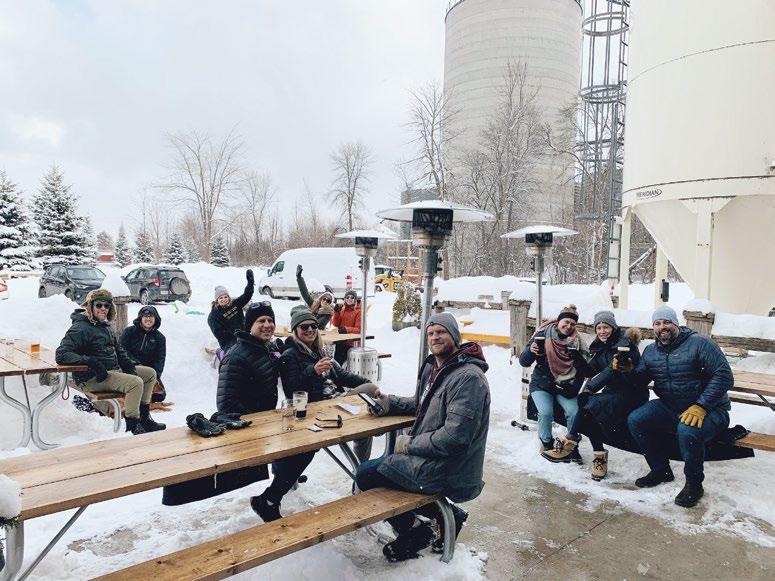
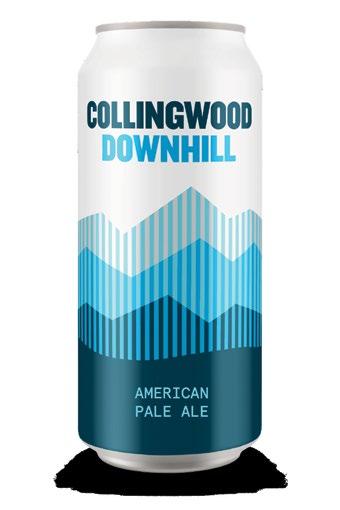

OPEN DAILY | Taproom + Patio + Bottle Shop 10 Sandford Fleming Drive, Collingwood, ON | 705.444.2337 | info@thecollingwoodbrewery.com
Wake Up and Smell the Psilocybin
For Collingwood-based startup Wake Network, mushrooms are medicine
words :: Ned Morgan
How do you feel about magic mushrooms? Chances are, you feel something. Isn’t this an illegal drug that causes users to freak out or, at the very least, laugh uncontrollably and talk a lot of nonsense?

As it turns out, mushrooms containing the psychoactive ingredient psilocybin possess a host of no-nonsense curative properties science is just beginning to understand. Numerous recent studies in North America and Europe have pointed to psilocybin’s benefits as a treatment for Post Traumatic Stress Disorder (PTSD), Attention Deficit and Hyperactivity Disorder (ADHD), addiction, depression and anxiety (including end-of-life anxiety).
This research emerged as laws prohibiting psilocybin have loosened over the last decade to the extent it can be studied in controlled, therapeutic environments. In Canada, magic mushrooms are still illegal to sell, possess or produce, but their listing in the Controlled Drugs and Substances Act (CDSA) has a loophole: They can be used legally in cases where Health Canada grants an exemption “for a medical or scientific purpose.”
Studying and producing psilocybin in the name of medicine and science is Collingwood-based Wake Network's mission. As the rest of the world progresses haltingly towards decriminalization, Wake is
focused on growth—of both the mushrooms themselves and on the “breakthrough therapeutics” they can confer on people in need.
Wake packages and sells medicinal mushrooms, including lion’s mane, cordyceps, reishi and turkey tail, and grows psilocybincontaining mushrooms through their biosciences/therapeutics division (which is collaborating on a genetics-based study on the remedial effects of psilocybin on traumatic brain injury). Wake Network recently built a psilocybin grow facility in Jamaica, where they also hold clinical retreats. Unlike in Canada and the U.S.—and most other countries in the western hemisphere—psilocybin is not a controlled substance in Jamaica.
Founder and CEO Nick Murray came from the tech world and started Wake in 2019, spurred by the illness of a loved one. “A close friend had been going through battles with cancer and we worked on a natural method to help strengthen her body,” he says. “And I found that it helped her—psychedelics did. So that’s what brought me to this space: seeing how [psilocybin] helped somebody really close to me. And I’ve always been interested in technology and how it can help validate natural methods of medicine.”
We caught up with Nick recently to ask him about all things Wake-related.
41
INNOVATION
Mountain Life: At your retreats, clients are administered clinical-grade psilocybin in a controlled, therapeutic environment overseen by medical professionals. Can you tell us about the increasing numbers of military veterans attending?

Nick Murray: For our retreats we’re working with a group out of the U.S. that serves veterans. They’ve got hundreds of veterans in need of therapy. And I see an overlap between civilians, so to speak, and the veteran population and some of the things they’ve experienced. With veterans there’s a lot that goes deeper than what happened in war. A lot of the time the reason they became a veteran was because of something else that happened in their past where they wanted to feel more powerful. So it goes deeper and further back than when they were deployed. There is a lot more overlap than you’d expect between the civilian population and the veteran population.
ML: Do you see the future of psilocybin as regular microdosing available to whoever needs it? Or as bigger doses once in a while to change one’s perspective, so to speak?
NM: I think it’ll be both. I think people will do a bigger dose maybe once a year, once every
couple of years, and then they’ll microdose more often. Everybody’s different. I see people that come from the depression world and the ADHD world who are both benefiting from psilocybin. And it’s a very strong reset when they do a macrodose.
ML: Do you think the future for Wake lies in the clinical retreats or the mushrooms themselves?
NM: In the products. We’ll be doing the retreats because in these early days of the industry we wanted to make sure that we had it in our hands and it was done to our standard. We want to be product experts and technology experts and help those people who want to do their own retreats, providing them with the technology—the booking and the telemedicine aspects, all of the pieces that go into operating it. But really our goal is to be a provider of the product. And that’s the functional and the psychedelic mushrooms.
Our Collingwood lab is licensed by Health Canada to do psilocybin biosynthesis, which is a process to make psilocybin compounds out of yeast. And the plan is to expand and grow the psychedelic variety in Canada, both in Ontario and Alberta.
ML: Why do you think Alberta Health Services (AHS) is on board with psilocybin therapy before anyone else in Canada?
NM: I think because they’re the most pissed off with Ottawa and fed up with waiting. And they’ve got a strong veteran population there. The first clinics [to administer therapeutic psilocybin] were in Alberta. They seem to be leading the charge to continue it. The people at the AHS seem to be more progressive, more open-minded, less scared.
ML: Do you see the future of the company in Jamaica, because the legal landscape for psilocybin is uncertain in Canada and elsewhere?
NM: We’ve been expanding the farm in Jamaica. It’s now the country’s largest psilocybin farm and we export to Canada and the U.S. Jamaica’s our research and development hub because we’ve got great relationships with the government there. But we know that Canada, the U.S. and the rest of the world will come along eventually. In the U.S., Oregon [which legalized therapeutic psilocybin, effective early 2023] is next, with Colorado to follow. It’s not retail, but it’s legal as long as somebody that’s been approved by the state is administering it. So we are seeing progress.


42
CLOCKWISE FROM LEFT The property in Jamaica where Wake Network holds its clinical retreats; CEO Nick Murray outfits former NHL enforcer Riley Cote with some wearable tech, part of Wake’s therapeutic toolkit; a healing hike on the retreat property.
SUPPLIED BY WAKE NETWORK







W W W C R I C K L O D G E M O B I L E S A U N A M E We Deliver a Nordic Wood Burn Cedar Sauna to You! Let’s chat about creating your new lifestyle in the Georgian Bay area! Brendan Thomson Sales Representative D: 705-606-1270 btrealestate2@gmail.com brendanthomson.com Chestnut Park® Real Estate Limited, Brokerage 393 First Street Suite 100, Collingwood L9Y 1B3 O: 705-445-5454 F: 705-445-5457 collingwood@chestnutpark.com
Chic-Chocs: True Eastern Alpine
 words :: Colin Field photos :: CHOK Images
words :: Colin Field photos :: CHOK Images
There are some first times that we will always remember. Like the time I skied off-piste through the alpine highlands of le parc national de la Gaspésie
Somehow I ended up at the top of a super-steep pitch with pro skier Samuel Grégoire. He was waiting for the filmers to give the green light. Then he’d drop in and show everyone how good the skiing in the Chic-Chocs really was. From here it looked sick… but intimidatingly steep; 30 cm of fresh snow stretched out for about 350 vertical metres below me. We were a crew of 12, with two filmers and one photographer slowing the pace. Somehow I was the second “athlete” in line. I was nervous because it’s not unusual for me to yard-sale on my first run of a trip. Plus I knew, as the lone guy from Ontario, I’d be judged harshly.
Grégoire dropped in, turning through the fresh snow beautifully, schussing down the slope with grace, power and speed. The crew whooped with appreciation and it was over as quickly as it began. The filmers reset, their lenses pointed at me. With 11 people watching, I was about to drop in, but I didn’t get to decide when. I heard the radio: “Tout est prêt?” I heard a drone buzzing above me.
“Okay, Colin! Three, two, one, dropping!”
And that was my cue. I side-slipped past a crevasse and then dropped in, following closely to the pro’s tracks; my first turn was good. My second turn: good. My third turn: success as well.
“Keep your hands out front,” I said to myself, “pole plant, pole plant, charge.”
The snow was incredible; the pitch was perfect as well. I knew I wasn’t skiing as well as the pro, but I was holding it together. Through the fresh snow, carving my own track down the face, I fell instantly in love with the Chic-Chocs. When I came to a stop beside the pro we high-fived and laughed at how fun that was. I pulled off my pack, pulled out my skins and got ready to head up again.
It was day one of a trip that had the working title of the Rab Steep Ski Camp. We were in a valley near the Gulf of St. Lawrence at
44 EPIC TRIP
Mont-Saint-Pierre.

After a couple more laps, we headed back to the Ski Chic-Chocs lodge where boiling water was already ready for the tote full of fresh snow crab. What a perfect ender to a day. Over beers and seafood, we laughed and partied to an early bedtime. The next day we headed to the area where local guiding
I was nervous because it’s not unusual for me to yard-sale on my first run of a trip. Plus I knew, as the lone guy from Ontario, I’d be judged harshly.
company Ski Chic-Chocs has tenure—the alpine terrain in le parc national de la Gaspésie. Once we got to the end of the road, we were loaded into Qamutik-style snowmobile trailers and towed up into the incredible bowl that is the Mines Madeleine. We unloaded and skinned up the 500-plus vertical metres. Our first lap was fun but marginal. Suncrust made for challenging skiing and a veil of fog blocked the scenery. On our second ascent, the sun broke through. It revealed a glorious view of the alpine. We were standing
45
less than a kilometre from Mont Jacques-Cartier, the highest point in southern Quebec.


It was then that I could tell there was debate about what to do. I was the lone anglophone on the trip but when I heard, “Ça vous tente-tu de skier un couloir glacé? On va faire du rappel pour l’atteindre puis on le descendra à ski.” I knew exactly what they were talking about. And I was fine admitting that, Hell no, I didn’t want to rappel into an icy couloir!
I took the easier but steep way down with a few other guys. Looking over the edge, it was difficult to tell if it was a cliff or a slope. Thankfully, we didn’t get cliffed out but skied heavy, creamy snow all the way to the bottom. Then we watched and heard the rest of the crew as they pendulumed off a rope into the couloir, then scratched their way down. It was cool to see. They all had bigger balls than I did.
Picked up by snowmobile again, we were returned to our camp for the next two nights: a row of Rab tents set up for us at the bottom of a beautiful bowl in the mountains. We watched the alpenglow of sunset, drank beer and ate a communal meal of curry in the dining hall/dance club dug into the three-metre-deep snow.
The Chic-Chocs are on most eastern skiers’ bucket list and with good reason. Few places in the east offer true alpine: skiable lines above the timberline where mountain peaks are bathed in white. We’re surrounded by rugged wilderness. It’s beautiful. And it’s an adventure worth putting in the time for. Getting here isn’t easy. A seven-hour drive from Montréal gets you started. It’s another mission getting to the ski trailhead. You really need to earn your turns. But part of the excitement and reward comes from the difficulty. Nothing worth doing is easy. And I’d do it all again in a heartbeat.
This story was produced as part of the Rab Steep Ski Camp, a media trip organized by the outdoor apparel and equipment company Rab in collaboration with Ski Chic-Chocs. For a similar experience contact Ski Chic-Chocs, which will offer a trip this winter in Gaspésie for the general public.
46

With Chestnut Park, you’re choosing performance. You’re choosing a premium Real Estate Brokerage. Over 30 years of industry experience 1990 Professional Agents serving clients 420 Markets served throughout Ontario 30 Chestnut Park prides itself on providing customized service that is highly personal, extremely reliable and reputably known, with the prestige of a widely recognized and respected brand. Quite simply, choose Chestnut Park. Find us locally: WIARTON | 519.534.5757 OWEN SOUND/TOBERMORY/SAUBLE BEACH | 519.371.5455 COLLINGWOOD/BARRIE | 705.445.5454 Chestnut Park® Real Estate Limited, Brokerage | chestnutpark.com
La Belle Verticale
Eastern Quebec’s Mont Ste-Marie, Les Sommets and Camp Fortune offer big vertical drops, unbeatable hospitality and epic terrain even in an ice storm
 words and photos :: Colin Field
words and photos :: Colin Field
Dropping in, it’s hard to believe we’re still in-bounds; the glades that make up the Klotz, Deep Purple and Vertigo runs are incredible. Steep, well-spaced trees descend the naturally extreme terrain. Bumps, rocks, cliff drops and platforms are scattered throughout. And it’s all open. Mont Ste-Marie lives up to its growing reputation as a seriously fun mountain. And while we don’t manage to hit it with a metre of fresh pow, we get a good idea of what it could be like. And it could be absolutely epic.
I definitely recommend going after a good dumping of snow. But even if you have to ski after an ice storm you’ll have a great time.
When we first heard about Mont Ste-Marie, it was touted as the latest and greatest mountain biking destination. Before that we’d never even heard of it. And we’d certainly never skied it. The main attraction? From Collingwood it’s a relatively quick six-hour drive. And with 1,200 vertical feet of terrain, it has the largest drop in the region.
Situated in the Outaouais region of La Belle Province, it’s a resort without all the hoighty-toighty accessories and mall-like villages that come with today’s mega resorts. And that’s part of its charm. The people here are skiers (or snowboarders!). They’re here to ski.
Two main chairs service the resort, complete with a train-like trolley shuttle that runs all day to take you from one chair to the other. There’s a really fun ski-cross course, a small terrain park, a friendly lodge with great food and all the charm you could ever ask for.

Of course sometimes you get straight-up skunked on ski trips. On our second day in Old Chelsea, Quebec, it rained nearly all day long— leading to a thick crust of ice that coated absolutely everything. So we went for a slippery but fun hike in Gatineau Park, checking out the Mackenzie King Estate and the park itself. Did you know William Lyon Mackenzie King was the prime minister for 21 years? And that his maternal grandfather, William
Lyon Mackenzie, was the first mayor of Toronto and leader of the Upper Canada Rebellion in 1837? I’m embarrassed to say we didn’t. But we learned a ton as we wandered and slid around his summer estate. It made for an amazing day off from skiing. The hills were closed anyway because everything was coated in ice.
In the afternoon we headed to nearby Arbraska Laflèche. This park is full of ziplines, treetop adventures and an incredible cave system. We hiked through the caves filled with hibernating bats (they look more like bat-cicles than mammals) and incredible, icy stalagmites growing from the ground. It was otherworldly and beautiful. They claim it’s one of the largest caves tourists can visit in the Canadian Shield. Our tour guide, whose name we were told was G.I. Joe, took us ziplining, but my family wasn’t into it. I did a short run above the lake and must admit I swore with fear more than once.
As always, dining in Quebec is a constant treat. Poutine at the ski lodge is a no-brainer and never disappoints. Our two-hour, multicourse dinner at Les Fougères was an incredible gastronomic experience and the town of Old Chelsea is full of gems like Le Pub Chelsea, Meech & Munch and Mamma Teresa.
We hit Sommet Edelweiss, which is another humble but fun hill, complete with a small terrain park, snow tubing and some standout poutine. Part of the Les Sommets group of ski hills, the five sister resorts include Sommet Saint-Sauveur, Sommet Gabriel, Sommet Olympia, Versant Avila and Sommet Morin Heights.
On our final day, the snow gods started teasing us. It was absolutely dumping. We skied Camp Fortune, which is a really fun hill. Lots of steeps, some glades thanks to our old friend Marc Charron (the Craigsmarc sous-bois)—but again, while we could see the potential, even the fresh snow couldn’t fix the icy crust below.
The number of resorts in this region is staggering. They’re everywhere. We skied three resorts in four days and barely scratched the proverbial (but literally icy) surface. I definitely recommend going after a good dumping of snow. But even if you have to ski after an ice storm you’ll have a great time. We’ll be back. And, Ullr-willing, we’ll get the goods.
48 RESORT TRIP




49
The Moody Bay
You can call them waterscapes, feelingscapes, thoughtscapes or abstracts, but Jeremy Down’s series of paintings of Georgian Bay will challenge your perceptions of the Sixth Great Lake

After talking to Jeremy Down I think about the landscape—in particular the waterscape—differently. The painter has based a recent series of watercolours on local freshwater colossus Georgian Bay. “Water’s like magic,” he says. “You can’t really paint it—it just keeps moving around.” For me this statement is a key to understanding Down’s series.
His are not the sort of landscape paintings that recreate or strictly represent the usual elements. Instead they use pattern, form and unusual colour palettes to suggest mood, movement and natural cycles. Down isn’t showing us pictures of water—he is painting ideas about its form and meaning. He explains: “For me, each mood has visual content. I don’t need reference photos. [The paintings] come from an experiential point, not a representational one. So even though I say they’re inspired by the bay, I’m not painting a picture of the water.”
ML sat down with Jeremy in his bright, spartan studio in a converted garage beside his home in Meaford, just after a November blizzard.
50 ARTIST PROFILE
words :: Ned Morgan // photos :: Kristin Schnelten
Truth Truce.
Mountain Life: Why a series about Georgian Bay?
Jeremy Down: Georgian Bay is a force. And I think that affects the way people are around here. They have a respect for weather and nature. The colours [in the bay series] are taken directly from sunsets or sunrises. There’s enough visual stimulus from the colours and moods of the bay to never get bored. And I’m coming from living on Slocan Lake [B.C.] which is super-stunning but in the winter it’s always socked in. It doesn’t have these layers of colour. For an artist that’s pretty inspiring.
ML: Can you tell me about the beginnings of the bay series?
JD: Bay Flow Number One was the first. And it’s not really a sunset; I was paddling over the shale layer out there. The clay is that bluish purplish colour. This was inspired by being way out there, on a flat day. And then I thought, There’s something that can happen with a series… I think there’s enough variety. When you’re developing a series, you want it to have longevity. Another early one was Truth Truce, which doesn’t look like water. But it sure feels like it to me. There are a few different points of content. There’s a kind of upward flow and spiraling here. After years of yoga practice and meditation, [I see the] spine as a conduit or a tree. A tree sucks water up into all the branches. They’re chakras, all the little points where your nerve centres bunch together. It’s connected to breathwork. And a lot of those subtle sensations are clarified after paddling on the bay because that’s what being in nature does.
ML: Wave forms permeate this series. When you’re surfing are you taking notes, so to speak?
JD: I see waves both in terms of the water but also waves in life, waves in patterns, in habits—and how waves hit each other and change, or bounce off the jetty. But because it isn’t literal, I’m thinking about how we live as humans, and our patterns and what they do into the future, because a wave has a time element. So you do something here, and it has a ripple effect into the future. And then when two waves meet, they clash.

ML: Could you talk about the inspiration behind Litany? You painted it after the passing of a friend and neighbour, is that right?
JD: As I was painting this I was processing [my friend’s] passing. I was on the water a lot—beautiful sunsets, warm colours and cold colours. But Litany is so simple. There’s no clash and not even many layers. The image is a traditional Japanese form that means waves or the ocean—this circle with another circle, and another circle. And they build on each other. I’ve played with it in a few paintings.
51
But Litany surprised me because I didn’t paint a lot of layers. I’m still processing this one, but when someone passes it’s kind of simple. It’s a weird thing to say, but they’re just gone.
And this one, Cathedrille, I was looking at like this [turns painting vertically]. And it seemed like an ice cathedral. These forms are like buttresses in cathedrals and we were at the funeral at the Anglican church in Meaford and I was influenced by that. And then there were some beautiful cold days last week. I had three days of waves and ice-blue water. And one day it was like head-high and barreling. I thought This is like a cathedral. It’s just so beautiful.
ML: Several of the pieces in the bay series look to me like hybrids of landscapes and abstracts, which you don’t see very often.


JD: That’s something I’m always playing with. You can see them as landscapes or feelingscapes or thoughtscapes because all those cues are in there. Landscape painting is pretty static and that’s not what this is. The bay never sleeps. Nature has always got something to give you. You just have to go find it. And so that means there’s always going to be another painting. And it’s intertwined with life. That was a big experience going to that funeral in the middle of the snowstorm and then [surfing] really good waves with nobody on them—it was a little scary because I was out there by myself. You talked about seeing the landscape, but it’s also abstract. Where those two meet—that’s my life.
See Jeremy’s art at the Craig Gallery in Meaford. www.jeremydown.com, www.labstudioclinic.com, www.mantrayogastudio.ca, @jeremy_down
Litany.

52
Cathedrille.










Marketing & Media Manager Mountain Sport Technician Adventure Tourism Guide Training Study and work in Whistler! Diploma programs are RESP eligible. Sharing our healing light with those who are looking to connect with who they really are and also to support a journey of well-being. beamlightstudio.ca 416.801.1276 @beam_light_studio Experience advanced light meditation with the Lucia No03 16 Bruce Street North, Unit 6 Thornbury, Ontario New Patients Welcome 186 Erie St Suite 202, Collingwood Phone: (705) 445-2470 eriestreetdental.com







Food , Bee r , Community d Your home is my business Let me help you find your dream home. Ellen Kalis Sales Representative 416-527-2896 ellenkalis@gmail.com ellenkalisrealty “Working with Ellen is a breath of fresh air” – Alex J.
Finding the Universal Broadcast
Composer Beverly Glenn-Copeland on the humbling and mysterious influence of nature
words :: Tom Thwaits
In 1986 Beverly Glenn-Copeland recorded Keyboard Fantasies using an Atari computer, a keyboard and a drum machine. After releasing it on cassette and selling maybe 50 copies, he went back to writing for Sesame Street making and the odd guest appearance on Mr. Dressup. In 2015, a cassette made its way to Japanese collector Ryota Masuko, a record store owner with a big online presence, who quickly bought, and then sold, all the Keyboard Fantasies cassettes he could find. Record labels worldwide lined up to reissue the hidden gem on vinyl. The momentum
of the rediscovery spurred Glenn’s return to touring in 2018 (at the age of 74), and inspired Posy Dixon’s Keyboard Fantasies, the internationally acclaimed film documenting this resurgence. Swedish pop icon Robyn wrote the liner notes for the reissue; Bon Iver covered the track “Ever New”; Caribou (Canadian composer Dan Snaith) credited Glenn’s recording as a defining influence. A new generation has embraced Glenn, a trans man, as a queer elder with wisdom to share. He has garnered attention from Pitchfork, NPR, The New Yorker, CBC's Q and now, after a recent move from New Brunswick to Grey County, Mountain
Life
Mountain Life: I once heard you describe yourself as a “woods monk.” Can you elaborate?
Beverly Glenn-Copeland: Well, I mean, “monk” is not really the proper word for it. It's more like I really love the woods and, basically, I don't need to see a lot of folks. The few friends that I have… I do really love to see them… but I do love solitude.
ML: How important was it that Keyboard Fantasies was written and recorded around Huntsville, in solitude?

55 MUSICIAN PROFILE
KARRI NORTH
BGC: One of the things that I love about the natural environment is you get to hear the call of the crows and their conversation, the ravens, the loons, and you can run up on things. I've run up on a cougar once! Bears are living in the woods. You're living with the natural environment and their life influences you in the sense that you understand what they need, and what's important for them. The same goes with trees, plants, probably stones, too. I would not have been able to write that in a city environment. Not at all.
ML: I like that you brought up stones. What's the attraction of geology?
BGC: I can't really say; I didn't grow up around great cliffs of rock. All I know is that when I saw great cliffs I went, “Oh, this is home.” That's what it felt like to me. That's the only way I can describe it. They came way before organic matter. The Canadian Shield is very ancient. To stand on rocks billions of years old and to realize that as the earth was forming, that was one of the first things that she came up with.
ML: Literally the foundation of the world.
BGC: I was living north of Huntsville when I wrote Primal Prayer, too. That was my day, that was my influence—the world, the natural world around me. The trees were quite wonderful for me to be in and among. To run through the woods and see not another soul and only life, the plant life, the animal life, things that swam in the water, that was really quite something for me.
ML: A return to the Shield.
BGC: Yeah, I lived in that area from probably '72 onward. For many, many years. I came away and lived in Montreal for a while but I ended up going back to that area after not too long.
ML: Even growing up in Philadelphia, your parents managed to find a place where you felt immersed in nature.
BGC: Yeah, I was very fortunate. From the age of 12 until I went off to university. It was a home where deer came up on the lawn and there were woods all around. That was wonderful; it was called Greenbelt Knoll. Kind of an amazing community—there were only 19 homes.
ML: When I hear words like “Philadelphia,” all I think is “concrete jungle.” Obviously, the lived experience can be very different.
BGC: Well, it depends. When I was a child, it was concrete streets. I don't remember seeing any trees on those streets. That was up until I was about three, with my grandparents and my parents living with them while they were trying to get money to have their own home. Then they moved to another area that had trees but, once again, it was still more concrete than anything else. Then, when I was 12, they moved to what felt like paradise to me.
ML: I'm fascinated by your creative process. You talk about a “universal broadcast system”—how would you describe that?

BGC: Ideas have a life and I call that life the universal broadcast system. They are not necessarily ideas that we are coming up with. That's not true for everybody but it is true. Most of my friends are visual artists and almost all of them say the same thing. They say, "I work on my craft, and I paint, or I do whatever I do, but my finest pieces, it's like, all of a sudden, my brush is being guided, this has just come and I'm just going with it.” They all say they feel like it was sent to them.
ML: Does spending time outside provide you
the mental calm required to be a conduit?
BGC: I'm describing what goes on for me. Of course, the type of friends that I have are more like me than a person who would live in a big city. But that's not to say that a person who's surrounded by concrete does not have or cannot have the same experience. I actually lived in New York City once, for one year and that was it. I couldn't deal with it. I felt like I couldn't see the sun. There were too many huge, tall buildings. I couldn't see enough trees. It wasn't for me. So I left it. But that's just me.
ML: It's very humbling to be able to speak with you.
BGC: I am humbled as well in the other direction. I keep meeting people who are so kind, and so loving and it's quite extraordinary. Really quite extraordinary.
I really wouldn't even be able to have this conversation if it wasn't for Elizabeth, my wife, who has been taking so much responsibility to help me be able to continue to do what I do at the expense of her own artistic work.
I feel like there is a very loving community that is in operation in the world today. And it's happening in all countries, where people are gathering and really caring for each other.
ML: We can only hope that trend will increase exponentially. As a final word, I need to share that I came to know your music via many, many surreal coincidences, and at a time when your serene melodies were needed, so to be able to welcome you to the area is nothing short of magical.


BGC: That's wonderful. It shows that we're all connected even when we don't know we're connected.

56





58
Back-to-Basics Brewing
words :: Colin Field photos :: Jaclyn Roth
Rolling up to the Still Fields Brewery just outside Meaford, a bald eagle circles the property and greets my arrival. I figure it’s a good omen. When I walk into the brewhouse itself, the guys laugh when I ask what their deal is.
“Our joke around here is it looks more like a winery than a brewery, we just happen to make beer,” says partner Owen Roth.
And it’s true; I’m not blinded by massive walls of stainless steel conical fermenters. It looks like a clean farm building with racks of barrels. There’s a brew happening as we speak, but you can barely tell anything’s going on because the kettle is actually outside.
“We’re trying to be a traditional farmhouse brewery,” says Roth. “We don’t have temperature control, we don’t have standard fermentation vessels. Our kettle just has an open flame underneath it. Start-up costs were lower and we thought there was a niche in the market. It’s a romantic idea of back-to-basics-brewing. We’re still loving it and people are recognizing that we’re making good beer pretty simply.”
All of the beers are barrel-aged and mixed-fermented, and their wild ale literally sits outside, exposed overnight to local yeast and bacteria, which then ferments the beer. They started with four core beers: lager, saison, hoppy saison and grisette. But they also release seasonal beers every couple of weeks. They’ve made dandelion beer; they’ve used blueberries, raspberries, strawberries, spruce tips, apple blossoms and honey in their beer. And there’s no end to their experimentation.
Roth cut his teeth at breweries including Mill Street, Bellwoods, Side Launch and Granite, so he knows what he’s doing. Brewing 450 litres at a time, up to three times a week, keeps them busy, and they’re keeping up with demand.
There are no plans to get Still Fields into the Beer Store.
“Our decision to not be in the LCBO or every bar or restaurant isn’t because we’re trying to be pretentious,” says Steven Ormsby, the second of three partners, who grew up on the property. In fact his great-grandfather bought the property and his father and brother still
farm in the area. The 22-acre parcel now includes a hop yard where they grow some of the hops for their beer.
“We’re just trying to grow slowly and incrementally. We don’t have any staff. If you come and buy beer, you’re going to talk to one of the owners.”
So where can you get Still Fields beer? Therein lies the charm: You need to visit the brewery itself (you can also order online). Visible from Highway 26, the distinctive green-and-white barns are open to
“Our decision to not be in the LCBO or every bar or restaurant isn’t because we’re trying to be pretentious. We’re just trying to grow slowly and incrementally.”
the public nearly every day of the year. There’s no massive asphalt parking lot, but the dirt and gravel spots will do. It’s a truly rural experience. In the winter they have fires going, there are covered picnic tables with patio heaters surrounding the barn and events are ever-expanding and evolving. They officially opened in September of 2021 and the summer of 2022 was a successful season complete with an on-site vintage clothing shop in a 30-foot Travelux (Canadian version of an Airstream) trailer.
The pet-friendly, kid-friendly brewery grounds are a four-season, on-site experience.
“The whole property is licensed,” Ormsby tells me. “We encourage people to just follow the tractor path; it takes you directly to the hop yard, and you can see Georgian Bay from the back of it, too.”
While you won’t find any double IPAs at Still Fields, you’ll find a well-balanced delicious brew. From the well water to the local hops, yeasts, bacteria and ingredients, these are beers that are totally unique to the area. And it’s an addition to our region we couldn’t be happier about. See you at the farm.
www.stillfieldsbrewery.com
59 FOOD/DRINK
traditional
seasonal beers
This small-batch
farmhouse brewery specializes in
FiNd YoUrSeLF iN NAtUre! Just a few minutes from collingwood, in one of canada’s 18 UNeSco biosphere reserves, are 370 unspoiled acres of mature hardwood forest. We are here, atop the Niagara escarpment, where snowshoers and cross-country skiers alike will enjoy our breathtaking world of adventure in nature!

Glide along our 27 km of professionally groomed cross country ski trails, or hike 12 km of snowshoe trails through a majestic forest.take in the spectacular views from Southern ontario’s longest Suspension Bridge or at Lookout Point N o r d i c c e N t r e




sceniccaves.com
RIDING FREE
Meet Hasina: Afghan snowboarder and Blue Mountain employee

words & photo :: Allison Kennedy Davies
When I pack up my car and head out the door to hit the slopes, I feel joy. But I’ve never stopped and truly considered how freeing that experience is. I’ve never given much thought to other women around the world being banned from sports. That is until I met 26-year-old Hasina Hussain Zada, a Blue Mountain Resort employee. Like many other Blue employees these days, she’s part of an increasingly diverse workforce. She’s quiet but once you get her talking, she’s willing to share her story. Hasina has only been in Canada for a few years, and her arrival was hastened by the advance of the Taliban in her home country of Afghanistan. Before she left, she and her friends had discovered a love of snowboarding, a sport new to her country. If anyone understands how valuable the freedom to ride is, it’s Hasina.
Mountain Life: For starters, tell us where you’re from.
Hasina Zada: I’m originally from the central part of Afghanistan, about an hour from the capital, but most recently I was living in Kabul.
ML: Can you tell us how you ended up coming to Canada?
HZ: It’s a very long story. Last year, the Taliban came in and took over Afghanistan and we were forced to leave. On August 26 of 2021, I left Afghanistan and I went to Ukraine where I stayed for 26 days. The Government of Canada was providing urgent visas to Afghans wanting to come to Canada. Some people went to Qatar and then came to Canada. That was an easier route but instead we went to Ukraine first. I am so glad that we didn’t stay long in Ukraine
because as you know things went badly there soon after. I came to Canada as soon as I got my visa. I stayed in Toronto for about two weeks and then I went to Southampton. Some friends asked if I would want to work at Blue Mountain. I said, “Sure, but I’d like to see it first.” So last October, I came to see Blue Mountain and I said, “Yes, I’d like to work here.” I applied for some jobs and luckily I got an interview for an administration job in the snow school. I did that last winter and enjoyed it. Since that was seasonal, I then applied to the purchasing department where I now work as a receiver. What inspired me to work in the industry was my love of the outdoors and the activities, sports and adventures that come with it.
ML: Before you came to Blue, you were involved with the Federation of Snowboarding in Afghanistan.
61 MOUNTAIN LIFER AT BLUE
HZ: Back in 2017, snowboarding was a new sport in Afghanistan. My friend, Ahmad Romal Hayat, was a skateboarder and he had heard about snowboarding. He wanted to bring something new to our country so he established the Afghanistan Federation of Snowboarding. Before that nobody even knew what snowboarding was. I was invited to be on his team; there were seven of us in total, six males and one female (me). We became the first snowboarders in Afghanistan—making me the first and only female snowboarder at the time.
ML: Are there many opportunities to snowboard in Afghanistan?

HZ: Afghanistan is a very mountainous country but it’s not a safe place for girls to do sports. A nearby province, Bamiyan, was open-minded and they welcomed all sports and women were allowed to participate. If we wanted to go snowboarding, we had to travel. I snowboarded as much as I could for a year and a half. By 2019, we had more girls join our team and eventually there were five of us.
It’s nothing like here in Canada where you can go snowboarding everywhere, anytime.
ML: What is the situation like now for your fellow snowboarders back in Afghanistan, particularly your female friends?
HZ: Since the Taliban came the situation has gotten worse. My female friends are banned from any sport, and my male friends don’t have the hope to continue right now.

ML: How do you feel about being able to snowboard, freely, as a woman here in Canada?
HZ: Finding the words to express my feelings is hard. I am thinking about the young girls back in Afghanistan who don’t have their freedom. I want to show, through snowboarding, that nothing can stop me. I will ride my snowboard for the freedom of girls in Afghanistan. I will encourage other Afghan females to ride with me and pave the road for those girls who can’t so that hopefully, one day, they can.
I am thinking about the young girls back in Afghanistan who don’t have their freedom. I want to show, through snowboarding, that nothing can stop me.
ML: Were you able to get out very much during those days?
HZ: Because we didn’t really have equipment and we had jobs and school, we’d go for three-day snowboarding trips and come back.
ML: With snowboarding being such a new sport in Afghanistan, were you surprised how popular it was here?
HZ: When I joined Blue, it was my first time working in a snow school department and
we had 250 instructors. It was so surprising to me that we had that many people just to teach people how to ski and snowboard. It’s amazing to see.
ML: What do your friends and family in Afghanistan think about your hitting the slopes in Canada?
HZ: My friends are all gone from Afghanistan. They are mainly in Europe and the United States. They want to come to Canada, too. When I share pictures they really want to come try the slopes at Blue. My family knows that I love sports and they understand. I do miss them a lot.
ML: What is the community like working at Blue Mountain?
HZ: When I came to Blue Mountain, I didn’t know much about the country and the people. I was worried I would make mistakes and people would not like me. But when I started working and meeting people, they are such nice people in the snow school that I felt comfortable very quickly. It’s been the same in the purchasing department—the people here are very nice too.
ML: What are you looking forward to most this winter?
HZ: I’m so excited to have more snow. I’m looking forward to getting more time in snowboarding and I’d really like to learn more tricks and advanced riding. I want to learn more and more and improve as a rider.
62
LEFT Hasina’s first time on a board, 2017. RIGHT The first meeting of the Afghanistan Snowboarding Federation. SUPPLIED BY HASINA ZADA




470 First Street, Collingwood (705) 444 6606 SHOP ONLINE AT FATHOMBOARDS.COM Arbor Bent Metal Burton Nidecker Nitro Ride K2 Lib tech Never Summer Capita GNU Flow ThirtyTwo Union Vans FAT IS FUN! SALES . SERVICE . RENTALS . SELECTION . FIT h U ge S elec TI o N o F FAT b I ke S AN d A ll T he ge A r T o ge T o UT T here AN d ped A l. 470 First St, Collingwood 705.446.1234










Imagine owning a home that combines the natural beauty of the area with all the amenities that only a 4-Season destination can offer. Opening doors to global connections with over 1,200 Christie’s International Real Estate Offices in 46 countries and 32,000 Real Estate Professionals. Buying or selling real estate? With Chestnut Park® we have what it takes to handle every detail of your transaction so you don’t have to. www.ThePicotTeam.com picot@rogers.com | C: 705.444.3452 *Sales Representative Chestnut Park® Real Estate Limited, Brokerage | 393 First Street, Suite 100, Collingwood, ON, L9Y 1B3 THE PICOT TEAM .COM COLLINGWOOD / BLUE MOUNTAINS TRUST | INTEGRITY | KNOWLEDGE | DISCRETION Wherever YOU ARE IN YOUR JOURNEY, WE’LL GET YOU INTO THIS LIFESTYLE MLS®40340631 | $4,915,000 101 Gindelwald Court, The Blue Mountains MLS®40301207 | $2,549,000 110 Aberdeen Court, The Blue Mountains MLS®40310762 | $2,099,000 178 Aspen Way, The Blue Mountains MLS®40345484 | $2,888,000 104 Hoggard Court, The Blue Mountains MLS®40268453 | $799,000 296 Lakeshore Road N, Meaford Ron Picot* Barb Picot*
Killing it Softly
Ski mountaineer Christina Lustenberger is blazing a smoking trail of first descents with a quiet but effervescent style that makes the terrifying look easy.
words :: Kevin Hjertaas
Lusti skiing powder in the Revelstoke backcountry. The prominent peak in the background is the iconic Mount Cartier (2,600 m). MATTIAS FREDRIKSSON

ATHLETE PROFILE
Getting your hair caught in a pulley is the opening of a good comedy scene—unless you’re dangling from a rope halfway up an ice cliff in the remote British Columbia interior. Christina “Lusti” Lustenberger laughs when she retells the story now, but it’s only funny to other twisted alpinists.
“That was actually really fucking sketchy. I was fully schnitzeled,” she admits.
Lusti and her ski-mountaineering partners had been on the go for almost 12 hours at that point. They were trying to move quickly through a dangerous part of a radical first-descent route when her long, curly brown hair went from flowing in the wind to jamming between her rope and mechanical ascender. Unable to move up or down, she was completely stuck in a bad spot. “I was putting my full body weight on my hair, and it wasn’t coming out,” she recalls.
It’s comically rare for hairstyles to impact mountaineering, but before anyone could chuckle about it, Lusti would need to find a way to get free.




























FULL SERVICE VACATION RENTAL MANAGEMENT We are a local team that embraces quality work, innovative technology and extensive market knowledge to deliver the best experience to guests & property owners. Professional Marketing Professional Cleaning Noise Control Hotel-Quality Linens Listing Creation & Booking Management Guest Screening, Communication & Experience Listing Price Optimization Your Property on 16+ Booking Channels (705) 481-0854 www.propertyvalet.ca Certified. www.highlandsnordic.ca ~ ski@highlandsnordic.ca 705-444-5017 Embrace Winter! 30km of classic & skate trails 3km groomed dog friendly ski trail 7km of snowshoe trails 10km groomed fat bike trails Your local nordic experts! ProShop Rentals Cafe mountainlifemedia.ca Instagram + Facebook @mountainlifemedia
Ski mountaineering at its outer limits—the edge defining what is possible to ski and survive—has always been celebrated for what it is: a serious pursuit. The heroes climbing and riding impossibly steep and dangerous mountains have become a large part of skiing lore. In North America, characters like Doug Coombs, Chris Landry and Doug Ward will have their stories recounted for generations. Collectively, these tales create an image of what this type of skiing looks like and what type of person leads the charge. It all looked very solemn, hard—grim even—until Christina Lustenberger.
A grizzled hardass pits themselves against a cold, unforgiving mountain, battling the elements upward until the climax when the hero sets their jaw, risks it all with a grimace and points their skis downhill. That cliché looks nothing like Lustenberger’s photos and videos. Those depict her and her friends smiling and laughing while skiing with impeccable style and high-fiving in matching, colourful, puffy jackets.
Of course, behind the pretty pictures is the same gruelling training regimen, deep motivation and all the requisite cold-mountain suffering; skiing bold first descents demands this of its practitioners. And over the past few years, no one has put up as many impressive ski lines as Lusti. She has earned the figurative crown worn by those past heroes, but there’s a subtle difference in how she wears it. Her combination of uncompromising alpinism and giggling irreverence makes that cutting edge look fun.
“It’s supposed to be fun, right?” she says with a shrug as she paces the Revelstoke, B.C., home she shares with husband Mike Verwey. She’s packing for an August ski trip to Chile and trying to explain how, when paired with the right partner, a team’s capabilities and attitudes can align in a perfect synergy to expand their comfort zone. “With that [skill and experience] comes a lightness while moving through the most difficult terrain,” she says.
Her most recent first descent, the Polar Moon Couloir on Baffin Island, highlights that phenomenon. Lusti and favourite ski partner Brette Harrington (see the recent movie, The Alpinist, for an idea of her climbing resumé) saw the line from a plane last spring and were instantly drawn to it. The 1,200-metre chute that cleaves the Walker Citadel looks like death on a stick to most skiers, but it’s also alluring in a haunting way; a deep, vertical ribbon of white framed by dark rock walls, interrupted at its midpoint by a 160-metre ice cliff.


69
"It’s serious, but if it’s not fun, why would you go back and do it over and over again?"
Lusti and Brette Harrington climbing a couloir up the Frigg Tower. STEVE SHANNON. INSET Lusti. MING POON

 Lusti charging Polar Moon Couloir, Baffin Island. INSET Polar Moon from afar. Circled is the area shown in the main image. JORDAN MANOUKIAN
Lusti charging Polar Moon Couloir, Baffin Island. INSET Polar Moon from afar. Circled is the area shown in the main image. JORDAN MANOUKIAN
“We were so far away from any type of rescue or help. We were out there,” recounts Lusti. “It’s a gnarly line, but things were going well. We climbed the ascent couloir, built an anchor to rappel in, and skied the hanging face above the serac ice. When we got to the ice, it was business time. Then on the second rappel, our rope got stuck, and all of a sudden we felt this huge blow from the weight and reality of where we were and how cruxy the situation was.”
They still had another 45-metres below them to get to the exit couloir. Their solution to the tension? Smile at each other and break it down into little steps. “We cut our rope into two 10-metre sections and did four mini rappels,” says Lusti. “Stuck on this crazy chunk of mountain, exposed to a lot of risk, we were just hanging off this anchor we’d built and laughing at each other. We were hour-whatever into the effort and out of water, and just giggling and getting through it.”
They were smiling but they recognized how critical the situation was. “For sure, we have to be proficient and get ourselves out of the mess we’d gotten into, but together we make a strong team. And I think with that sort of trust you can add an element of fun in these crazy landscapes. It’s serious, but if it’s not fun, why would you go back and do it over and over again?”
When one spends 30 years dedicated to a sport, they earn the confidence to enjoy such challenges.
Born in Invermere in 1984, Lusti grew up ski racing at Panorama Mountain Resort where her parents owned the ski shop known to everyone as, of course, “Lusti’s.” From that little local club, she trained and worked her way right to the Canadian National Team and the 2006 Turin Olympic Games—adding a top-ten finish at a World Cup giant slalom in Germany. She’d reached the upper echelon of the racing world, but Lusti was just getting started in skiing.
Having accrued multiple knee injuries, she retired from racing and moved to Revelstoke, where she turned her focus to backcountry skiing. Freeski icon Eric Hjorleifson recalls Lusti’s early backcountry winters: “I remember hanging out in Revy and watching her ski her way through all the core skiers in town. She’d go out with these people and ski them into the ground. Then they’d have to take time off to recover, and Lusti would move on to the next group. She’s relentless. She loves the grind.”
Of course, behind the pretty pictures is the same gruelling training regimen, deep motivation and all the requisite cold-mountain suffering; skiing bold first descents demands this of its practitioners.
Lusti’s pace was relentless, but also measured. She knew not to rush it when absorbing the lessons of safe mountain travel. Six years after leaving racing behind, Lusti earned her ACMG ski guide qualifications, another career path for most skiers that includes avalanche, first aid and guiding courses, work practicums and exams spread out over a few years. At the same time she was preparing to start a new career as a guide, the ski media had also started to take notice of her smooth, capable and impressive skiing.
Many ex-racers try freeskiing for the cameras, but their style, developed on icy slopes, doesn’t always translate well to film. Hjorleifson watched Lusti master this aspect of the sport. “She has a polished technique, very strong with a lot of power, but she’s been able to adapt that and become efficient and very smooth. She still maintains the strength in her turns, but she doesn’t look like a racer—she’s adapted to the environment.”
Sherpas Cinema saw the same thing and featured Lusti in their film Children of the Columbia. It earned her a nomination for Female Athlete of the Year at the 2019 Powder Awards, the kind of recognition sponsored skiers build entire careers on. She's also become a staple in Teton Gravity Research's annual ski film, cementing her place as one of the sport’s best and most recognized athletes.
Most pro skiers would be content putting out a film segment every year that keeps sponsors happy and fans watching. But Lusti has always been drawn to ski mountaineering, where rope work and technical climbing are required. Hjorleifson admires that. “She’s so motivated on her own goals and ambitions with ski mountaineering that she doesn’t fit into the mold of a normal pro skier. She just does exactly what she wants to do, and in a way, that’s why she’s the best.”
So, in what seems to be a fourth act after racing, guiding and movie skiing, Lusti is combining her fitness, mountain skills and skiing technique and taking it to where her heart is—amongst steep, rocky, glaciated peaks. In recent years, she’s teamed up with professional climber and closet skier Harrington to push steep skiing into bold new realms; the duo can climb things skiers can’t, and ski things climbers can’t, collectively blowing minds in both worlds.
One of those blown minds belongs to freeskier Cody Townsend, the biggest name in backcountry skiing these days with his The Fifty Project on YouTube. “Lusti is one of the best ski mountaineers in the world; in North America she might be the best,” says Townsend. “The lines she’s skiing first are aesthetic but with such a high degree of difficulty that she’s leading ice climbing pitches with skis on her back. Only a few people in the world are doing what she’s doing.”
71
Ski what you’ve been missing.

SunPeaksResort.com
A perfect example of this cutting-edge ski mountaineering was Lusti and Harrington’s 2021 descent of the Gold Card Couloir. The line dangles between Mount Burnham and Mount Grady in B.C.’s Monashee Mountains like an ice-age, mountain-sized snotsickle. It’s a line for skiers to fantasize about but never actually ski. Just to reach the base of the 800-metre couloir, the team—Lusti, Harrington and Andrew McNab—had to drive 45 minutes up logging roads, ride snow machines for more than an hour with all their gear, then ski tour for two hours. Their first attempt ended halfway up when spooky ice conditions turned them around, and they had to reverse their efforts to get home by 7:00 p.m.

After a day recovering and eating massive amounts of cheesecake, they again left early, determined to make the descent a reality. The subsequent pictures and videos—seen across all major climbing and skiing media outlets—could trick one into thinking it was easy: Lusti smiling at the top, coiling a rope around her leopard-print neck tube with light reflecting off her Oakley goggles and shiny North Face down, or her powerful, perfectly balanced turns on the narrow snow between jagged rock and blue ice. Lusti’s Instagram caption only adds to the image, “Cute and Cold. In that order.”
Which returns us to the moment when “cute” had a cost that left Lusti dangling from her hair and that rope. Stalled halfway up the couloir and struggling to find a way out of the jam, she wracked her brain for a solution. “I was really stuck, and we had no time. So, I took out my V-threader with the little knife blade on it and cut three inches of hair out of my Micro Traxion.”
The ordeal put the crew further behind on what was already a dangerously long day. “We had to redline the upper pitch and push on the descent. When we finally skied it all down to the lake, it was time to turn on headlamps. We still had to ski out to the sleds and ride back to the trucks in the dark.”
The Gold Card Couloir was a significant accomplishment, but it was just one of five notable first descents that season for Lusti—the kind of annual output that has become standard for her. But more than the volume of descents, it’s how she makes the terrifying look easy that has earned her the respect of her peers.
There’s no gold medal handed out for skiing the scariest, most impressive lines, but those involved in the sport seem happy to pass the proverbial crown to Lusti and see where she’ll take it.
Gold Card line. STEVE SHANNON
The line dangles between Mount Burnham and Mount Grady in B.C.’s Monashee Mountains like an ice-age, mountain-sized snotsickle.



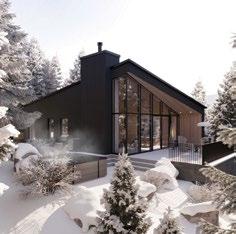
We remain at your disposal for any further information. Register and stay informed • www.lhymnedestrembles.ca THERMAL SPA EXPERIENCE & OUTDOOR POOL TREE HOUSE WITH OUTDOOR FIRE PITS AND LIVING SPACES DOPPELMAYR SKI LIFT SKI RUN WITH DIRECT CONNECTIONS TO MONT-TREMBLANT MOUNTAIN TOWNHOMES 28 MOUNTAIN CONDOS 36 15 MOUNTAIN HOMES AMENITIES PHASE 1 & 2 Delivery April 2024




TAR & CHIP RO A D SURFACING Providing Tar and Chip paving, parking lots, driveways, golf cart paths, wineries, and roads 647-456-2010 l info@tarandchip.ca l tarandchip.ca
At Home in the Woods
An A-frame on the Bruce Peninsula updates a timeless design

 Schnelten
Schnelten
Tucked deep into the Bruce Peninsula backcountry, a quiet black A-frame peeks from the shadows, tidy and comfortable in its woodsy surroundings—looking every bit a reclad relic from the 1960s.

But the new build, a four-season cottage project undertaken by Guelph couple Marissa and Casey den Ouden, is just a few years old, conceived during a 2018 hike with an old friend.

“My girlfriend’s cottage is across the street, and I grew up going there as a teenager, year-round. I’ve just always really liked the area,” says Marissa. During a March visit, the two families were walking nearby trails when Marissa discovered the treed lot, just a block away from the shores of Lake Huron, was coming to market. “We weren’t even looking for a second property,” she remembers, but the price tag was reasonable and the timing was right.
Planning began immediately for the house, which was intended from its inception as an income generator. Their gravitation to the architectural design had roots in Casey’s own adolescent memories of a lakeside A-frame in Quebec, although that structure was likely a summer cottage.
“It’s not a really common building in our climate,” says Casey, noting their desire for an exposed-rafter look would require a second, faux, roof beneath necessary insulation. But nostalgia for a time and place—the freedom of childhood in the outdoors—took precedence.
They added a sizeable bump-out to the traditional A-frame shape but followed interior convention: The primary living space is open to the high peak, with two second-storey bedrooms and a third
on the main floor. Tongue-in-groove pine lines the walls and retro fixtures feel at home among sparse, homey decor.
“When we started designing it, I didn’t want it to be fancy. I wanted it to feel like it had been there for a while, and had collected things,” says Marissa. “I like going to the flea market or thrifting, so it was kind of an excuse to buy some kitsch-y, cool stuff.”
Officially ready for their Airbnb launch in winter of 2020, the den Oudens waited patiently for bookings to trickle in. Then March arrived.
“The world felt like it was ending,” remembers Marissa. “But it was like a blessing in disguise. Nobody could leave the country, so everybody just booked cottages.”
Booked solid for their first year, their learning curve could’ve been steep. But area connections helped ease the transition, with a local couple on board for guest prep and solid relationships with local trades established during the construction phase.
And the project is still evolving, with a wood-fired sauna added in 2019 and plans underway for a changing hut, where guests can gear up into snowshoes and skis before heading out on the trails.

With a generational cottage elsewhere, the family’s time at the property is limited to periodic maintenance trips. During those brief visits, the couple’s three children adventure in the forested trails and nearby beach, building lifelong memories of their own. “The kids always ask, ‘Can we go to the A-frame? Can we go to the A-frame?’” says Marissa. “They just love it.”
Marissa keeps former and future guests, as well as fellow A-frame enthusiasts, in the loop via their Instagram account @heaframe.
77 MOUNTAIN HOME
words & photos :: Kristin




Contact Jamie Hibbard 705-994-3272 jamie@hibbardproperties.ca www.hibbardproperties.ca 156 Jozo Weider Blvd, Suite 9, Blue Mountains YOUR 4 SEASONS LOCAL REALTOR ® Luxury Real Estate This magazine will be reforested. PrintReleaf’s certified open-source program measures the paper consumption of Mountain Life Media and printer Solisco—ensuring trees are automatically replanted across a network of Canadian and global reforestation projects. Printing since 1991
GRAVEL PLANS
Bike
words :: Molly Hurford photos :: Jody Wilson
In recent years, gravel riding (and racing) has become more popular with cyclists for a few reasons. The first is that it’s just plain fun— there’s a sense of adventure that comes with riding down a lonely country road. The second is its relative safety: On gravel roads, you contend with less traffic and cars are generally moving slower. At the same time, gravel riding isn’t quite as technical as mountain biking, so you’re less prone to crashing. Here in Simcoe County and the surrounding areas, there are dozens of fantastic gravel roads just waiting to be explored.
Excited? There are a few things you should know before you go, especially if you’re a road rider who’s hitting the dirt for the first time.
You’ll go a lot slower on gravel. While gravel isn’t quite as slow going as mountain bike trails, you won’t be speeding along like you would on fresh asphalt, either. Assume that an average ride will take anywhere from 10 to 25 per cent longer than a road ride of the same

79 WHEEL WELL
tires crunching down gravel roads is a sound of springtime
Gravel Greatest Hits, Simcoe-Grey
Sideroad 12/6th Street Extension A favourite interval hill and one of the longest/hardest climbs in the area. Only a 20-minute ride from the town of Collingwood. Once at the top of the climb (which may be snowy into spring), you have many options to make a short or long gravel ride on the top of the escarpment.
10th Line/Little Germany Ride rolling gravel through the Kolapore Uplands. Great to link with the Sideroad 12 climb, this is a quiet section that twists and turns with several fun corners and scenic rocky outcroppings.

Lower Valley Road Out of Kimberley, this hidden gem gradually climbs south toward Flesherton in the valley, passing Beaver Valley Ski Club and Hoggs Falls.
Sideroad 30/31 This road parallels but also connects to Pretty River Road (a paved favourite for local roadies) and Concession 10. Sideroad 30/31 provides some fantastic views of the bay while you grind it out on rolling gravel hills. Combine it with Reids Hill for a very challenging ride close to town.
Sideroad 20/21 Known to some as the “goat path,” this road is best accessed by riding the Train Trail from Collingwood until it ends, south of Stayner. Make a right onto 20/21 and head west on a great flat road that becomes very narrow and hilly after you (carefully) cross Highway 124 to climb toward Highlands Nordic and return to Collingwood on the newly paved Concession 10.
length and plan accordingly. So if your gravel ride is 40 kilometres and you’d normally ride that in two hours on the road, you should budget at least an extra 30 minutes for the gravel version. It may not seem like a big deal, but consider the potential food and water you may need for that extra 30 minutes—remembering that gravel is often much more remote than paved roads and refills might be fewer and farther between—and think about when the sun is setting. You might be able to squeak in that road ride before sunset, but the gravel version could have you finishing in the dark.
Expect an adventure. In this area, everyone has seen “No Winter Maintenance” road signs. You’re going to be riding a lot of those if you embrace gravel riding, and that means you may encounter everything from rock slides to ice-covered roads, even in early May, and some roads will look more fit for a downhill bike than a car. The unknown is half the fun! Don’t be afraid to get your feet wet or your bike dirty.
While gravel gear is becoming more and more ubiquitous, don’t let the desire for a new bike stop you from exploring the local gravel roads. If you want to get started riding gravel, you don’t need a gravelspecific bike (though it is nice to have). You can pedal with whatever bike you have. Run what you brung, as they say. To make a road bike more gravel-friendly, simply swap your normal road tires for the widest option that will fit and drop your tire pressure (ideally down to around 65-70 PSI, but more if you’re a heavier rider) to give you as much cushion as possible. You may also want to start wearing gloves with padded palms to dampen the vibration from washboard gravel. If you can, swapping to a set of mountain bike shoes and pedals will make walking rough sections a lot more pleasant. And finally, make sure you bring extra flat-fixing supplies, as you’re more likely to flat on gravel roads than on asphalt.
To make a road bike more gravelfriendly, simply swap your normal road tires for the widest option that will fit and drop your tire pressure for as much cushion as possible.
80
Edition
























Everything for your winter cheese needs! Fondue, Raclette, Catering Boxes & Gourmet Foods 11 BRUCE STREET SOUTH, THORNBURY 519-599-6699 SH OP ON L IN E AT T H ECH E ESEGAL LERY. COM ! C O L L A B O R A T I V E R E A L E S T A T E C A B R I N G Y O U R R E A L E S T A T E D R E A M S T O L I F E FEATURE LISTING YOUR OWN PRIVATE BOUTIQUE HOTEL Listed at $5,188,000 View all available properties scan above K A R E N E . W I L L I S O N Sales Representative, ABR®, SRES®, CLHMS® Call or Text 705-888-0075 330 F t S ree Un t B Co ngwood TOP 2% N CANA A collingwoodclosets.ca Locally designed, manufactured and installed since 2007 416 721 9940 robertk@collingwoodclosets.ca Horse-drawn sleigh rides daily Tours are weather permitting and must be booked in advance. To book, call 519-240-0660. Located at 615852 3rd Line RR2 Ravenna.
The Pollination Bomb

Insect decline is a big—and mostly overlooked—piece of the biodiversity loss puzzle
“If all mankind were to disappear, the world would regenerate back to the rich state of equilibrium that existed ten thousand years ago. If insects were to vanish, the environment would collapse into chaos.”
So said eminent biological philosopher and author E.O. Wilson, an entomologist who specialized in ants (and coincidentally coined the term “biophilia”). The quote resurfaced in a 2014 book by biologist Dave Goulson, the world’s foremost expert on the behaviour, ecology and conservation of bumblebees. In Goulson’s A Buzz in the Meadow, Wilson’s quote is a springboard both to declare that insects are vanishing worldwide, and to question our lack of concern. Goulson contrasts the ramifications of no insects—i.e., potential global cataclysm—with something of far less consequence on which we expend much conservation capital: the ever-lovable panda, whose disappearance, while symbolic, might mean only “… a tiny bit more bamboo in a forest in China.”
His point: big, cute animals like pandas speak to our philanthropic instincts, while most insects—animals we barely notice—do not. Adjusting our attitude toward insects as a group would be a first step to taking their declines seriously. As winter moves into spring and another year of insect Armageddon looms, it’s an issue worth considering.
Fortunately, the insect world has its own pandas, and these do have our attention. Accelerating declines in wild pollinators like butterflies and bees, and annual losses of up to 80 per cent of hives of the yeoman European honeybee (employed in agriculture around the globe), have been big news. With pollinators required for reproduction in 90 per cent of flowering plants and three-quarters of crop species, worldwide declines raise the spectre of global food shortages. Beyond humans, fruits and seeds derived from insect pollination are on the menu for a quarter of all birds and mammals.
But while pollinators’ important ecological roles were once familiar to most, times have changed: a study in Britain found one in
82 BIOPHILIAC
words & photos :: Leslie Anthony
ABOVE A bee-imitating hover fly visits a yellow water lily blossom. RIGHT Butterflies like the tiger swallowtail can be important pollinators.
five schoolchildren had never seen a bee in the wild; worse, half their parents didn’t know bees help pollinate crops. No surprise then that bee declines have sparked an industry of public-awareness initiatives and global citizen-science partnerships.
“People can tell a robin from a chickadee and numerous other birds, but when it comes to bees, they might only recognize honeybees and none of the 20,000 other species globally,” says Dr. Elizabeth Elle, a biologist at Simon Fraser University in Vancouver.
Elle researches the role of wild pollinators in threatened natural ecosystems as well as agricultural settings. She found that wild pollinators become more important to agriculture when there are natural landscapes nearby. This, however, also makes them more vulnerable to the negative effects of agricultural practices. Because bees supply their nests with pollen, they visit flowers more often than the wasps, beetles, flies, hummingbirds and untold other species that do so simply for food. As a result, bees are increasingly susceptible to the cumulative effects of anything nasty that might be in that pollen. Cue the much-discussed use of bee-killing neonicotinoid insecticides here
“Our problems with honeybees have to do with how we raise and move them around, the pesticides we use and the diseases they carry,” notes Elle. “And yet wild pollinators are also in decline for reasons that are far less clear—though possibly related.” About 20 years ago, the Western bumblebee was considered the second most common bee in Vancouver-area blueberry fields. Not so today. “We didn’t see one for the first four years studying those areas,” says Elle, “then this year saw one.”
This same story—insert different crop or different bee—can be excavated anywhere. That was clear in a 2011 study by American researchers who compared current and historical abundance in wild North American bumblebees that showed four species had declined by up to 96 per cent. More notably, declining populations exhibited less genetic diversity and significantly higher pathogen loads than non-declining populations, to the extent the authors felt such metrics were “realistic predictors of these alarming patterns of decline.”
While reasons for wild bee declines remain enigmatic, the precipitous downturn in monarch butterflies is sadly understood. As recently as the 1990s, a billion of the iconic orange-black “king of butterflies” migrated south each fall from central and eastern North America to overwinter in south-central Mexico. By 2014, only 56.5 million remained, a decline of more than 80 per cent from the 21year average. Although the slide was linked to agricultural practices that decimated milkweed—the plant on which monarch eggs hatch and spend the larval stage—factors such as climate change, degradation of overwintering sites, pesticides, disease, predators and parasites all exert pressure on the species. With most of these issues ongoing, the milkweed deficit was merely a tipping point.
The importance of wild pollinators to natural ecosystems is underappreciated; when pollination breaks down, less food for everything leads to upwardly cascading changes everywhere in the food chain. “As a conservation biologist, I can tell you we know that insect species are being lost across the planet,” says Elle. “Are we seeing the same thing for insects with regard to biodiversity loss and the sixth great extinction? Yes. Are we recognizing insects as in particularly steep decline? No… but no one is really looking.”
If no one is looking at insects in general, how to judge broader patterns? Perhaps through something that depends on them—like birds, which indeed turn out to also be in steep decline (subject for another column). But while sudden changes in insect-dependent
animal populations offer a research roadmap into some declines, what about cases of slow, steady attrition?
Walk the shoulder of any Ontario highway in summer and you’ll notice an unusual number of ants underfoot. Why? Because they’re enjoying a 24/7, all-you-can-eat buffet of insects killed by motor vehicles. One of few studies on this issue was carried out by a team from Sudbury’s Laurentian University led by Dr. James Baxter-Gilbert, on sections of Ontario’s Highway 400 that traverse the amphibious landscapes east of Georgian Bay.
Over two summers Baxter-Gilbert collected 117,000 roadkilled insects during daily surveys of a two-kilometre stretch of highway. Though large, this number represents only a fraction of what was actually killed: Countless individuals were stuck to vehicles, obliterated on the pavement, too small to see or scavenged by animals like ants. The collection was dominated by Hymenoptera (bees, wasps, etc.), Lepidoptera (butterflies, moths) and Diptera (flies, mosquitoes, etc.). Fully a third were pollinators. “That might seem disproportionate,” notes Baxter-Gilbert, “but it makes sense when you think about who’s flying around at car level. We concluded insects are dying on roads in astronomical numbers—especially those super-important to ecosystems.”
What does astronomical mean? Even the most conservative estimates seem insane. Highway 400 is a medium-use road of 10,000 vehicles/day in an area of medium insect diversity. Extrapolating to the entire length of similar roads in North America, Baxter-Gilbert’s group came up with 10 billion Lepidoptera, 25 billion Hymenoptera and a staggering 60–190 billion Diptera deaths per year.
“We don’t know what these kinds of numbers mean,” notes Baxter-Gilbert. “We’re assuming 25 billion individuals is significant, however, we have no clue how much loss an ecosystem can sustain. Especially with pollinators.”
But does it matter? Maybe not, says Elizabeth Elle. “Just because we can’t put a finger on an exact cause of insect declines doesn’t mean they aren’t all important,” she says. “As Dave Goulson puts it, ‘If a middle-aged, out-of-shape, overweight guy dies from a heart attack, you don’t ask what killed him—it was, obviously, everything.’”

83
“We concluded insects are dying on roads in astronomical numbers—especially those superimportant to ecosystems.”
–Dr. James Baxter-Gilbert

84 84 GALLERY

85 85
Backyard SUP serenity at Dyer’s Bay, Bruce Peninsula SCOTT PARENT
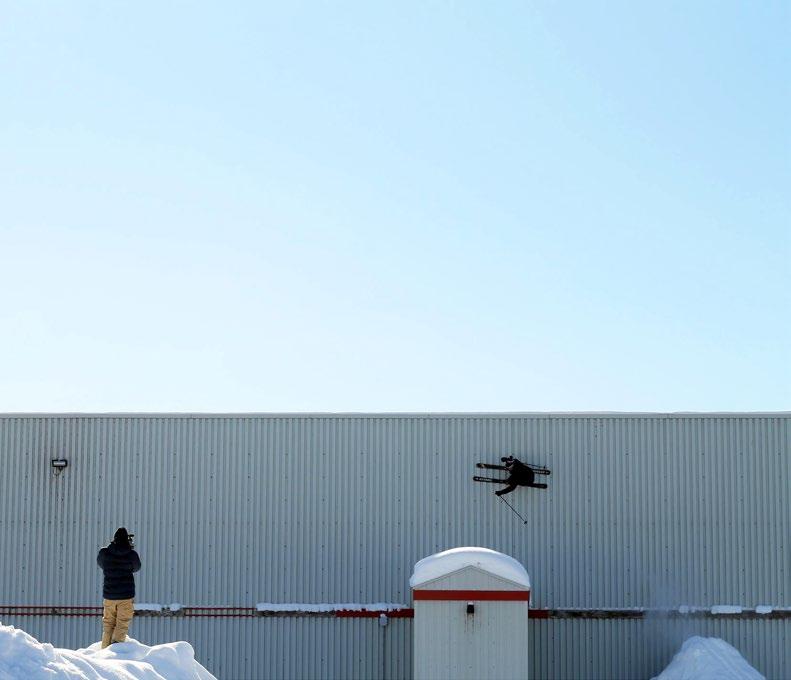
86 86
Matt
Wilcox. TRENT PIPHER

87 87
Heather McGee and Jason Bayens on the Beaver River. COLIN FIELD

88 88
Greg Sturch COLIN FIELD


THE DREAMLINER Ski · Snowboard · Alpine Touring · Mountaineering · Inline Skate · Waterski intuitionliners.com
MIKE TRASLIN ANDY TRASLIN
Here in Simcoe County we love bikes! Mountain bikes, road bikes, gravel bikes, tall bikes and even e-bikes! Throughout the year, there’s an event for just about everyone. Whether you’re a die-hard gravel rider, a fully armored downhill warrior or a comfort-bike meanderer, there’s an event for you. So hop on two wheels and let’s ride in Simcoe County.

HARDWOOD SKI AND BIKE
One of Simcoe’s early adopters to mountain biking, Hardwood Ski and Bike has been a mainstay of mountain biking for decades. You can ride here nearly any day in the summer, with something for the whole family.


If you want to become part of the mountain bike community, getting out for an event is a perfect way to make friends, have fun and challenge yourself. Here are some events worth checking out.



HARDWOOD WEDNESDAY NIGHT MTB RACES May 10 to Aug 30





The Wednesday night series at Hardwood Ski and Bike has been running for decades now. It’s a fun cross-country race that is appropriate for any level of rider. The friendly community is sure to welcome you with open arms. To finish reading this story, visit the Mountain Life website at www.mountainlifemedia.ca/SimcoeSpring
 Photos by Colin Field
Photos by Colin Field
4 →

1. THE NORTH FACE HEATED MONTANA INFERNO GLOVES offer three distinct levels of heat so you can customize your comfort depending on windchill and weather patterns. With up to 8 hours of heat, Etip functionality and brushed high-pile linings, these gloves may just be the most valued addition to your cold-weather kit. www.thenorthface.com //

2. The RAB KHROMA KINETIC JACKET is their softest ski-mountaineering hardshell. Their signature Proflex fabric is a trifecta of backcountry comfort: It’s stretchy, breathable and durable. Forget about strain and struggles, the shell’s flexibility makes transitions in the mountains smooth like butter. Check out the matching bibs at www.rab.equipment/ca // 3. If a smoothness indicator existed for skis, the ELAN RIPSTICK 96 would be off the charts. It’s a true freeride ski that doubles as an all-mountain ski for those who want ultimate versatility. It utilizes Amphibio Carbon Line technology for dynamic power and precision and a re-shaped tip and tail taper design make it a perfect choice for every day, every turn shape, on any surface. www.elanskis.com //

4. INTUITION HD RACE LINERS are made of high-density foam, adding stiffness to the flex of the shell for more aggressive skiers. The Moccasin-tongue style pattern minimizes pressure points over the instep, with minimal seams and stitching with extra stiff cuff and tongue reinforcements for maximum protection from shin bang. www.intuitionliners.com //

5. The YETI ROADIE 48 WHEELED COOLER is built for navigating tailgate crowds and taking lunches to go, with the same cold-holding power you’d expect from a Tundra. And from the handle to the durable wheels, this thing is virtually indestructible. www.yeti.ca

91 5 → 3 → 2 → 1 →
6. Utilizing Gilltek technology, the ORAGE MORRISON GILLTEK puffy jacket combines warmth with breathability in a lightweight package. When you're still, the “gills” lay flat and provide a comfortable insulating layer, yet, when you're moving, the heat can dissipate through the mesh to prevent overheating. www.orage.com // 7. The JACK WOLFSKIN ROUTEBURN PRO JACKET offers PrimaLoft insulation and Texasshield Pro shell fabric, both made from recycled polyester, to effortlessly withstand cold gusts of wind and rain. An adjustable hem and comfy stretch fleece assure optimal freedom of movement, and three pockets offer easy access for all your essentials. www.jackwolfskin.com // 8. Say goodbye to uncomfortable folding chairs or extremely heavy Adirondack chairs. The KUMA LAZY BEAR CHAIR has supreme comfort and ample space to kick back. Includes cushioned seat and back, insulated drink holder and phone pouch. Rated for 350 lbs. Double and heated versions also available. www.skiisandbiikes.com //



9. The NORCO BIGFOOT 2 excels in all seasons and extreme terrain to make every ride big fun. With maximum traction in the most extreme riding conditions, Bigfoot claws its way up, and the finely tuned steering geometry and massive tires provide confident, aggressive handling to rip back down. www.littleeds.com // 10. A winter glove with anti-smell lining, you say? Count us in! The SWANY X-PLORER GLOVE is made to handle anything winter can throw at you. The extra-warm Triplex Alpha insulation and stem finger construction keep fingertips warm while remaining waterproof and breathable. Includes handwarmer pockets, pre-curved fingers and full leather palms. www.swanycanada.com


92 7
6 → 8 → 9
→
→ 10 →















Cycle. Hike. Snow. Shop. Snack. Experience LOCAL 194355 grey road 13. beaver valley. eugenia garage13.ca garage13.bv 866.504.8091 Try one of our many varieties of Activated Turmeric Elixirs & Syrups to sip, warm, cold, or get creative and kick up your favourite beverage. roottofruit.ca 188 MARSH STREET, CLARKSBURG 57 Hurontario St., Collingwood (705) 445-6222 Shop online at mindsalive.ca The laTesTToys books and crafTs for kids Outdoor toys • Craft Kits & Supplies • Games & Puzzles Science kits • Puppets & dress-up • Infant toys • Thomas And books for infants to teens Shop on line at www.mindsalive.ca Mon.-Fri. 9:30-6:00, Sat. 9:30-5:00 Sun. 11:00-4:00 NOW OPEN IN DOWNTOWN COLLINGWOOD! 27 Hurontario (705) 445-6222 10073 MTNLF Minds Alive_Winter 2010_FNL.indd 1 The latest toys books and for kids of all ages Monday to Wednesday 10:00-5:30 Thursday and Friday 10:00-6:00 Saturday 10:00-5:30, Sunday 11:00-4:00 The Latest Toys, Books and Crafts for kids of all ages Outdoor Toys • Craft Kits • Games & Puzzles • Building Toys Science Kits • Puppets & Dress-up • Infant Toys • Books for infants to teens
11. A classic with a twist, the COLUMBIA WOMEN’S KEETLEY BOOT packs warm insulation, a fleece collar and Omni-Heat Infinity thermal reflective lining to keep toes toasty. The leather upper with Omni-Tech waterproofbreathable construction stands up to weather, while a responsive, cushioned TechLite+ midsole and an Adapt Trax wet-dry traction outsole let you roam freely. And the COLUMBIA MEN’S SNOW SLAB BLACK DOT JACKET redefines comfort on the slopes. This stretchy shell boasts an industry-first thermal shield that traps heat with Black Dot technology, Omni-Heat Infinity thermal-reflective lining and Omni-Tech seam-sealed waterproofbreathable construction. Columbia at Blue, 152 Jozo Weider Blvd. or www.columbiasportswear.ca // 12. The NIDECKER SUPERMATIC is what snowboarding has been waiting for: the first universal, dual-entry, automatic binding. The Supermatic works using a triggered high back called Drop-In Tech. A simple release lever makes exiting just as rapid. And it works with any boot. www.corbetts.com // 13. Maintain your fitness through the winter with 2200 watts of resistance and enjoy riding around the world on the WAHOO KICKR V5 virtual smart trainer. It's super-fun and an incredible workout. www.kamikazebikes.com // 14. Ride without bindings on the new K2 TREE SPLITTER UNISEX SNOWBOARD. On the mountain or in your backyard, the extruded 2000 base ensures a reliable gliding experience. Tech features include a directional rocker profile with a forgiving veneer core, a traction pad and a paracord leash. Macalin, Fathom Boards, Collingwood. www.fathomboards.com





94 14 →
12 → 13 → 11 → →



@axedthrowing RECREATIONAL AXE THROWING INDOOR AXE THROWING IN THE HEART OF BLUE MOUNTAIN VILLAGE. OPEN 7 DAYS/WEEK! BOOK ONLINE! axedthrowing.com 220104 AXED_Mountain Life Media Horizontal Half Ad.indd 1
15. Did you know 40 to 45 per cent of body heat is lost through the head and neck? Treat yourself to a PUFF puffy-warm face protection made of ethically sourced white duck down—and stay outside longer. Designed in the Blue Mountains. A portion of the proceeds is donated to Protect Our Winters Canada. puffdesigns.ca //
16. Bursting with aromas of passion fruit, lychee and citrus, BLACK BELLOWS SHINNY FUEL is 100 per cent juicy. The stars of the show are hops from Australia and the Pacific Northwest. www.blackbellows.com // 17. The ARC’TERYX RUSH INSULATED JACKET delivers reliable weather protection for ski touring and splitting adventures. Windproof, water-repellant and highly breathable, the GORE-TEX INFINIUM outer utilizes Hadron face fabric for maximum durability and minimal weight. www.arcteryx.com // 18. After a day of skiing/boarding, relax with a RAVENSBURGER WINTER MOOSE PUZZLE. Puzzling develops logical thinking and problem-solving skills, memory, focus and concentration. Check in-store or online for current selection. www.mindsalive.ca //



19. FISCHER ONE and FISCHER TWO kids’ ski boots are easy and intuitive to put on, thanks to a unique wideopen entry design and closure systems that are kid-tested and parent-approved. The warm and durable doublelayer waterproof gaiter construction protects young feet from the wet and cold. www.fischersports.com //


20. Pale gold, intensely aromatic and fortifying—COLLINGWOOD BREWERY SKADI IPA is fit for the gods. Based on their Downhill Pale Ale, it's brewed with a staggering amount of Amarillo, Cascade, Mosaic, and Simcoe hops. At 7.2 per cent, with aromas of grapefruit and orange, this beer is our gift to those who seek adventure. www.thecollingwoodbrewery.com

96
15 → 16 → 17 → 18
19
20
→
→
→











Visit us at www.meaford.ca (519) 538-1060 tourism@meaford.ca SHOP | EXPERIENCE | ENJOY For these great shows and so many more go to meafordhall.ca Come play with us...we’ve got it all!
Ramblers
Take the Chill Out of Winter with Great Entertainment! Where the acoustics are renowned, and intimacy is
its best! issEmily Whitehorse R e d DirtSkinners uG n ning&Cormier ar ts & cultural centre Since2006 The
Fun things to do, all
February 2 - The Slocan
Bluegrass at its best! February 25 - Miss Emily 2 time Maple Blues Female Vocalist of the year award March 1 - Gunning and Cormier March 30 - Roots ‘n’ Blues Kitchen Party Suzie Vinnick, Charlie A’Court, and Lloyd Spiegel April 16 - Ron James April 22 - Red Dirt Skinners Echoes of Pink Floyd but more energetic, echoes of Supertramp and harmonies reminiscent of ELO April 27 - Ian Thomas April 29 - Elvis ‘68 Comeback Special Steve Michaels May 6 - Lighthouse May 13 - Jersey Nights Music of Frankie Valli and the four seasons May 24 - Whitehorse
at
Slocan Ramblers
winter long!
Zen and the Art of Fly Fishing
 words :: Bobby Koven
words :: Bobby Koven
I faithfully practice mindfulness and I’m also a fly fisherman. Do these passions have a common element?
Spring in our four-season playground brings the return of multiple quiet outdoor activities that can turn hours into minutes: hiking, biking, kayaking, canoeing—and fly fishing. With the seasonal melt, our world-class rivers are primed again for trout fishing. The Mad, Pretty, Nottawasaga, Beaver, Bighead and Sydenham flow east into Georgian Bay while the Saugeen, Rocky Saugeen, Maitland and Grand flow west into Lake Huron.
Trout season—brown, speckled, rainbow and brook—opens the last Saturday in April. Whether you’re fishing the headwaters, your secret spot or the river mouths, the first trout of the year is always memorable. In fly fishing, the size of the catch does not matter; big or small, they all count.
As the water is colder and faster at this time of year, I use a nine-foot rod (8-weight) and tie my own flies with bead heads, a lot of purple marabou and maybe some split shot. I recommend fishing the prime water (feeding lanes), getting your flies deep and keeping a tight line to set the hook.
Wooly Buggers (hook size 12-14) are my spring go-to fly. If

you’re fishing early in the season, most flies are at their nymph stage. But wearing a hat will help protect you from other bugs, the sun and that odd stray fly that might strike you in the head (whether it’s windy or you’re out of practice). Adding a pair of polarized sunglasses will allow you to actually see the trout.
Trout season—brown, speckled, rainbow and brook— opens the last Saturday in April.
Good waders and boots are a necessity and of course that cigar (or two) to keep the bugs away (cigar smokers will use any excuse). I don’t wear a watch, but use the cigars and sun as nature’s timepiece.
And of course you’ll need a fishing license unless you’re 65 or older. At this time of year, the fish are hungry due to a long winter of really doing nothing, but they call it fishing, not catching, so enjoy the journey.
As with mindfulness, hours turn into minutes and typically I fish alone, enjoying my Zen time.
Flyfishing Bob is a local fly guide and environmentalist. He teaches fly casting and promotes catch-and-release to keep our rivers and fish vibrant.
98 BACK PAGE
COLIN FIELD






































































































 BEN POECHMAN / FREERIDE COLLECTION
BEN POECHMAN / FREERIDE COLLECTION




















































 words :: Heather Thompson
words :: Heather Thompson





































































































 words :: Colin Field photos :: CHOK Images
words :: Colin Field photos :: CHOK Images




 words and photos :: Colin Field
words and photos :: Colin Field











































































 Lusti charging Polar Moon Couloir, Baffin Island. INSET Polar Moon from afar. Circled is the area shown in the main image. JORDAN MANOUKIAN
Lusti charging Polar Moon Couloir, Baffin Island. INSET Polar Moon from afar. Circled is the area shown in the main image. JORDAN MANOUKIAN











 Schnelten
Schnelten




























































































 words :: Bobby Koven
words :: Bobby Koven










